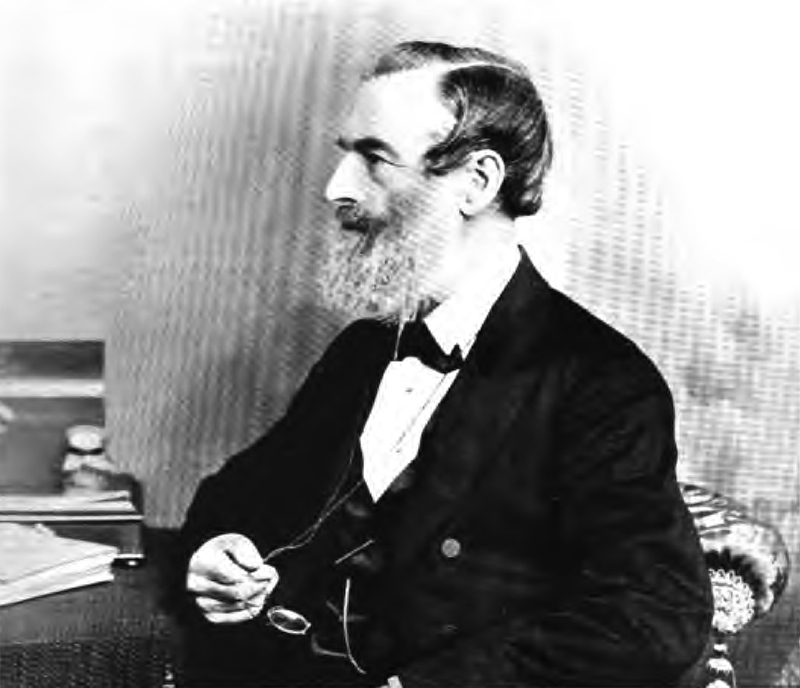
Figure 1. Edmund Wheeler, from a photograph owned by Frederick Enock. Studio props indicate that the picture was taken by Wheeler’s son in his Brighton photographic studio.
Edmund Wheeler, 1808 - 1884
by Brian Stevenson
last updated November, 2021
Although best known today for his high quality microscope slides of enormous variety, Edmund Wheeler generally described himself as being a science teacher. He travelled Great Britain for several decades, presenting lectures to schools and public forums on astronomy, optics, engineering, thermodynamics, entomology and many other topics. In between lectures, he produced slides and instruments, and managed a successful and continually expanding optical business. His strenuous life was probably made even more difficult by the death of his mother and two brothers when he was only two years old, and the early deaths of his wife and all three of his daughters. His nephew, Frederick Enock wrote of Wheeler that “the high pressure strain he put on himself could not be borne for ever, and … he began to give way.” In the autumn of 1884, dying of tuberculosis, Wheeler sold his business and moved to Brighton, to be with his only surviving child.

Figure 1.
Edmund Wheeler, from a photograph owned by Frederick Enock. Studio props indicate that the picture was taken by Wheeler’s son in his Brighton photographic studio.
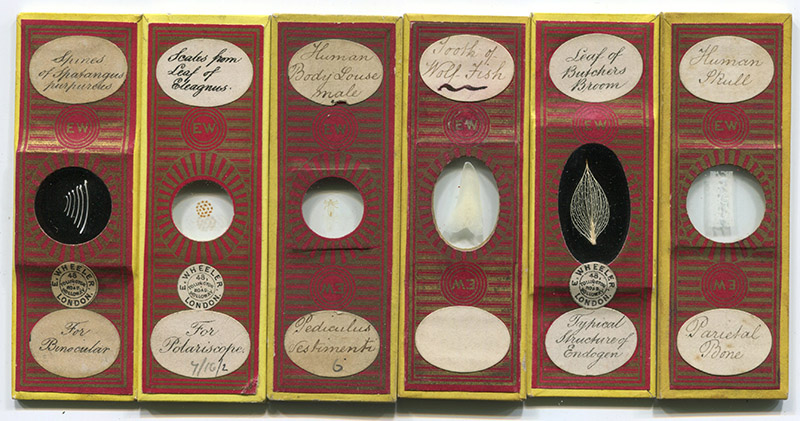
Figure 2.
The most commonly encountered paper-wrapped slides have gold-on-red paper on the front and plain yellow paper on the back and edges. The patterned front paper carries Wheeler’s initials on either side of the specimen. Descriptive labels may be either handwritten by Wheeler or type-set in a similar font.
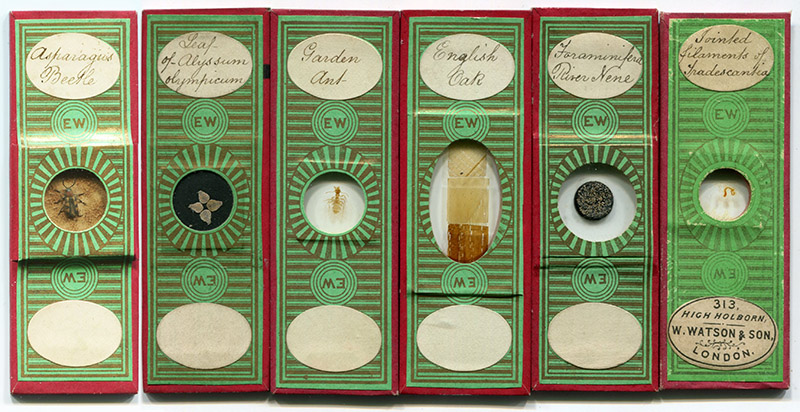
Figure 3.
Somewhat less frequently encountered are Wheeler’s gold-on-green printed papers, with red or purple edge and back wrapping. The slide on the right indicates that Wheeler sold slides through Watson several years before his death, as that company’s name changed from Watson & Son to Watson & Sons in 1882.
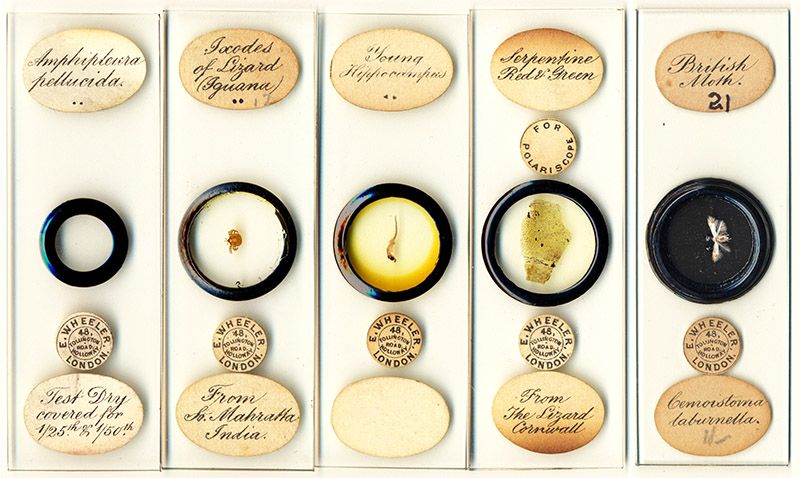
Figure 4.
Unwrapped slides, with plain black ringing are very common, and generally bear type-set labels. Such slides are often encountered with circular labels from Watson and Son, suggesting that these were the sorts of slides produced by Wheeler at the end of his career and subsequently purchased by Watson.
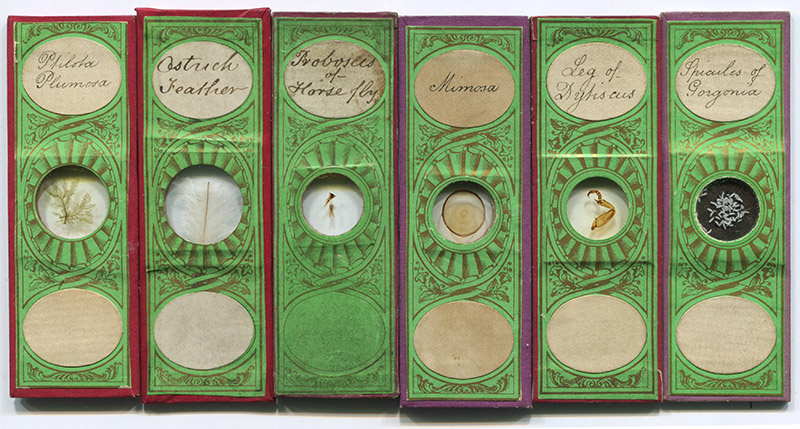
Figure 5.
Howard Lynk (2010) provided compelling evidence that these slides were produced by Edmund Wheeler. They have generic gold-on-green front papers and red or purple back and side wrappings, bearing specimen labels with Wheeler’s handwriting.
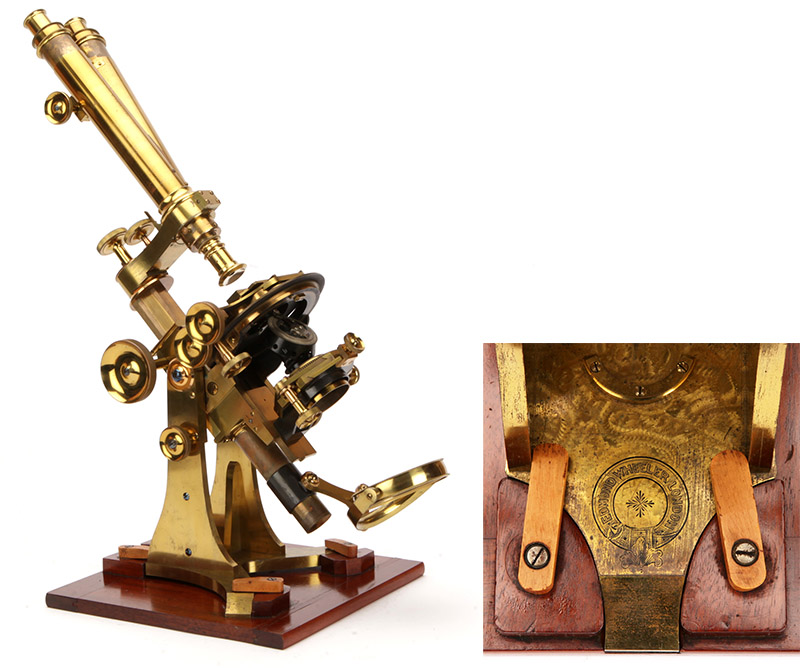
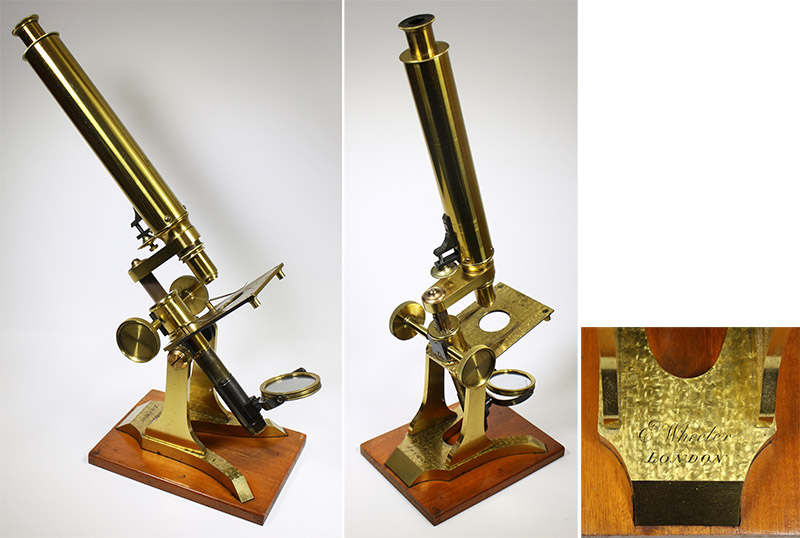
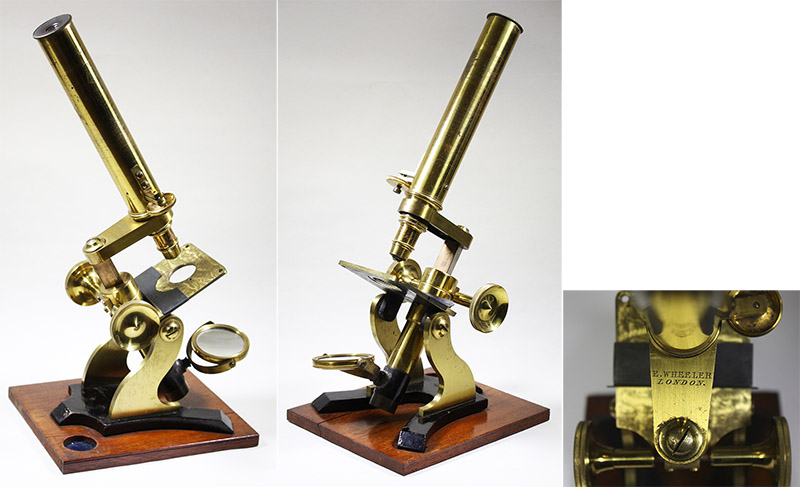
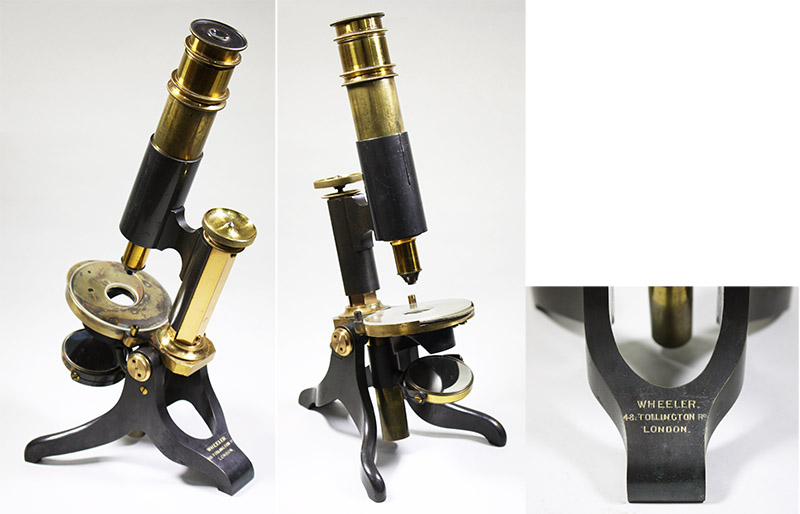
Figure 6.
Four microscopes by Edmund Wheeler. Top to bottom: a "Stand A", first-class model, which was shown in his 1869 catalogue (see Figure 15); a "New Educational" model, also shown in the 1869 catalogue; a similar model that was not in that catalogue; and a later model with drawtube coarse focus. W.B. Carpenter and J. Hogg recommended Wheeler’s instruments and lenses for their high quality. Some images adapted for nonprofit, educational purposes from internet auction sites.
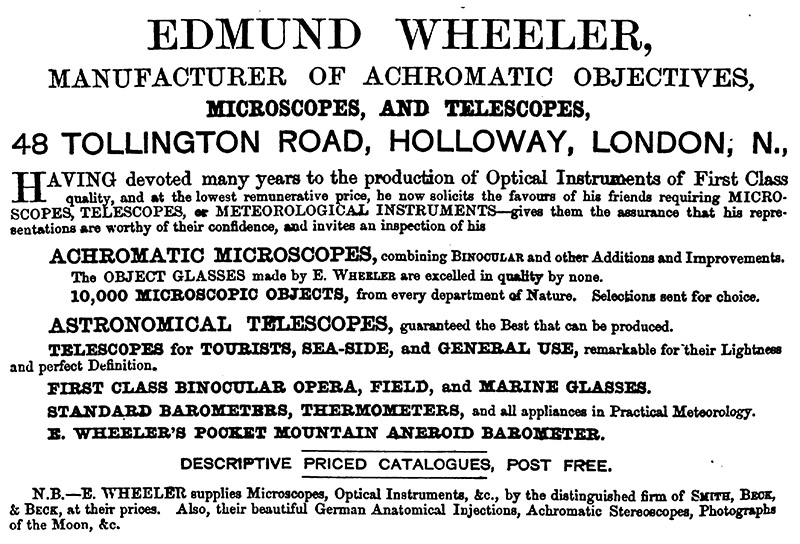
Figure 7A.
A May, 1863 advertisement for Wheeler’s microscopes, lenses, slides, telescopes, and other optical and scientific apparatus, from “The British Friend”. Note that Wheeler also retailed material from Smith, Beck and Beck, anatomical microscope slides by Karl Thiersch (see Figure 7B), and photographs of the Moon by Warren de al Rue.
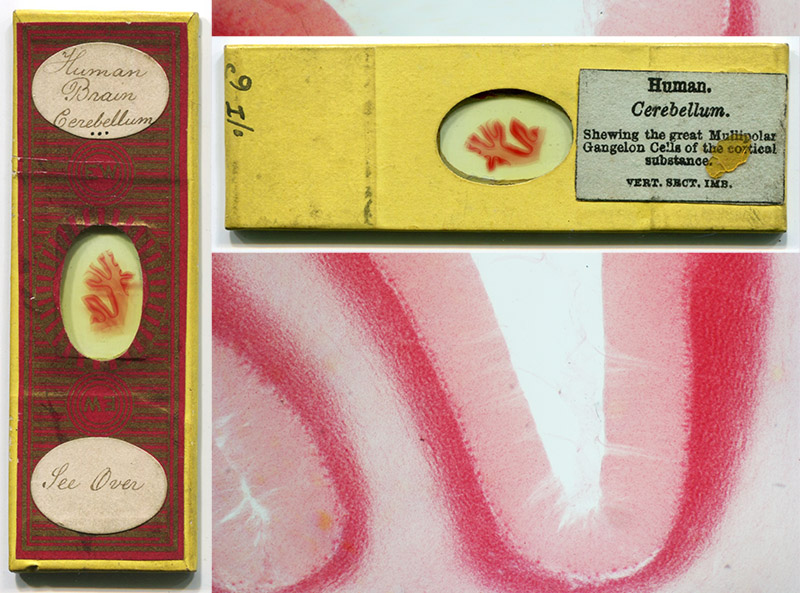
Figure 7B.
A microscope slide that was retailed by Edmund Wheeler, yet produced by the German anatomist Karl Thiersch (1822-1895). Wheeler attached Thiersch’s characteristic label to the reverse of the slide, along with a note to “See over”. The 1863 advertisement shown in Figure 7A states that Wheeler then sold such slides.

Figure 8.
An advertisement from the March 15, 1883 issue of “Nature”, indicating that Wheeler continued to manufacture microscopes until nearly the time of his death.
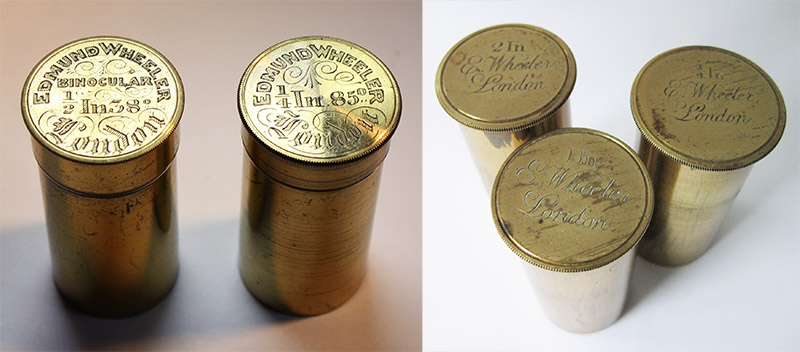
Figure 9.
Objective lens canisters inscribed by Edmund Wheeler, with lenses inside. Right image, courtesy of Trevor Gillingwater.
Wheeler the ironmonger
Edmund Wheeler was born on November 25, 1808 in Strood, Kent, into a family of the Society of Friends (Quakers). His father, Samuel, was a grocer and cheesemonger in that town. Samuel married Sarah Horsnaill in 1806 and they had four children, all boys, of which Edmund was the third. Tragedy struck the Wheeler family in 1810, when Sarah and two of the sons died, leaving an elder brother, Frederic, and Edmund in their father’s care. While there is no direct information on Edmund’s education, his brother Frederic attended the Quaker school in nearby Rochester. It is likely that Edmund was also educated there. The school enjoyed a reputation for the quality of its teaching in several branches of the sciences, a grounding which was likely to have had a major influence on Edmund’s life.
Through Quaker records, we can piece together early stages of Edmund’s career. In 1823, he registered with the Folkestone Meeting (which included Dover), returned to Rochester in January, 1830, then moved back to Dover in 1832. There, he established an ironmonger business at King’s Street, Market Place, seemingly on his own account. In Edmund’s day the term ironmonger embraced a range of metallurgical skills, which would have required him to serve an apprenticeship. Edmund’s apprenticeship most likely took place during his 1823-1830 stay in Dover, where his mother’s brother, William Horsnaill, was an ironmonger. Considering the family connections, it is probably not a coincidence that William’s son, Edward Horsnaill, became a noted amateur biologist and microscope slide-maker.
Edmund married Caroline Enock on February 20, 1833, declaring himself on his wedding certificate to be an ironmonger in Dover. He certainly owned the business in King Street by 1835 because, when a fire broke out only two doors from him, his warehouse was described as “Mr. Wheeler’s property”. Fortunately the fire was quickly contained, otherwise the damage to the town might have been very extensive, since Wheeler had 8 hundredweight of gunpowder stored in his warehouse. That considerable quantity of explosive suggests a business that was more diversified than described in his advertisements (Figure 10).
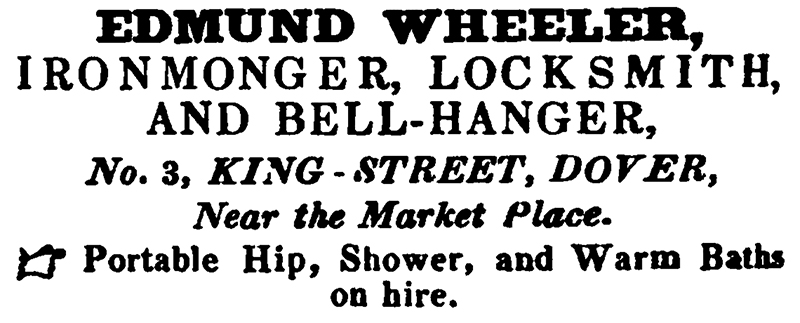
Figure 10.
An 1842 advertisement, from “The New Dover Guide”.
Caroline, his wife, died of tuberculosis on September 17, 1842, at only 35 years of age. This left Edmund to look after their four young children: Sarah Ann (born May 5, 1834), Edmund Jr. (born March 16, 1836), Sophia (born March 29, 1838) and Caroline Mary (born in the fourth quarter of 1840). Caroline’s death was probably anticipated because (a) she died in Strood, not Dover, (b) a press announcement dated 14 August, 1842, stated that Wheeler’s Dover ironmongery had been acquired by Thomas Ismay and (c) prior to Caroline’s death, Edmund had advised the Folkestone Meeting of the family’s intended departure from the area.
They moved to Birmingham, Caroline’s home town, where Edmund might have expected help from the Enock family. Curiously though, he lived on Wellington Road, about 6 miles away from Caroline’s two surviving siblings, Sophia and Robert, who lived in the Hunton Hill / Erdington area of Birmingham. The baby, Caroline Mary, died of a “fever” on January 24, 1843. The death was witnessed by Hannah Moore, a member of the local Quaker community, suggesting that she took care of the children while Edmund worked. It is not known what he did for employment in Birmingham.
Shortly afterward, the Wheelers relocated to Basingstoke, Hampshire. Edmund was recorded as again working as an ironmonger. He became a member and, subsequently, a vice-president of the Basingstoke Mechanics’ Institute. During their 1845-46 session, he gave at least two public lectures on scientific matters. These lectures were favorably received by the press, suggesting that they were probably not his first attempts at public lecturing. In the Institute’s 1846-47 session, he delivered a lecture course at the Town Hall, on “steam, steam navigation, railways and locomotive power”. Edmund had practical experience on those topics, and in 1847 was awarded a patent for “improvements in valves for steam and other engines”. Curiously, he declared that he had become possessed of this invention “through a communication from a foreigner residing abroad”. The application was still permissible because patent had not yet been granted for England, Wales and Berwick-upon-Tweed, where it was to apply. Also in 1847, Edmund became a member of the British Association for the Advancement of Science, possibly to aid his growing career as a lecturer.
He moved to London in 1848, and evidently continued production of iron implements. He presented a display at the 1851 London Exhibition, in Class V: “305. Wheeler, Edmund, 2 North Buildings, Finsbury Circus - Inventor and Patentee. Equilibrium slide valves for steam engines, to relieve the valve from the pressure due to the elastic force of the steam”. The 1851 Exhibition effectively marked the end of the ironmonger phase of Wheeler’s life. That occupation was replaced by the life of a travelling lecturer.
Wheeler the Lecturer
The move from Basingstoke to London would have aided Wheeler’s career as a professional lecturer, affording him opportunities with the capital city’s many scientific and social organizations, along with a concentration of contacts through whom he could arrange talks elsewhere in the country. He moved the family to different locations in London during this period, first to 47 Nelson Square in 1848, then, within two years, to 2 North Buildings in Finsbury Circus, followed by 43 Queen Street, 11 William Street by 1857, and finally 48 Tollington Road, Holloway, by 1862. That last address was his home and business location for the rest of his working life.
As already indicated, Edmund had delved into public speaking during the mid-1840s, or possibly earlier, and evidently enjoyed it. This occupation quickly took over as a major income source, such that he described himself for the 1851 census as a “Lecturer on Natural Philosophy”. Later in 1851, he described himself more fully as “Edmund Wheeler C.E.” (Civil Engineer) and “Lecturer to the Metropolitan Literary and Scientific Institutions, the Yorkshire Union of Mechanics’ Institutions and the Western Literary and Scientific Union of Devon and Cornwall”, indicating the broad institutional base on which he was establishing his career. Edmund’s lectures were very popular, as judged by press comments:
“Mr. Wheeler is without doubt one of the best lecturers in England - his style is plain, vigorous and striking, never failing to bring home his facts and experiments to the mind of every listener.”
“It is difficult to describe, and words inadequately convey, any idea of the variety, brilliancy and beauty of Mr. Wheeler’s experiments.”
“The lecturer (Mr. Wheeler) treated his subject with that happy, fast lucidity of statement and ready fluency which have acquired for him such a distinguished reputation as an expositor of popular science.”
“Those who anticipated a pleasant evening’s amusement, blended with instruction, ran no risk of being disappointed. Mr. Wheeler’s lectures are never dry, as he has the happy faculty, while keeping the instructional purpose of his lecture steadily in sight, of investing his subject with a quiet, dry humour, that succeeds in securing the undivided attention of his hearers.”
Frederic Enock later commented that one of Wheeler’s “lecturing sprees” might last for 6 weeks. A surviving advertising flyer claims that Wheeler delivered his Ocean Telegraph lecture nearly 100 times during 1870-1871. A hint of the rigors of Wheeler’s lecturing circuit is found in reviews from 1852: He spoke on December 1 and 8 at Windsor/Eton "On the Electric Telegraph, its Principles and Practical Use", and, in between, on December 7 at Newbury on "The Telescope and its Relation to Astronomy” – those towns are about 40 miles (65 km) apart, a significant distance 160 years ago. Identified records, which are undoubtedly incomplete, show Wheeler talking in 42 different locations outside London. These stretched to the north into Scotland, to the west into Wales, to the east to Hull and Grimsby, to the southwest as far as Exeter, and to the south to Dover and Portsmouth. Those efforts indicate a truly punishing schedule, and certainly justify Wheeler describing himself as a scientific lecturer rather than optician in the census returns of 1851, 1861 and 1881.
Identified titles of Edmund Wheeler’s lectures:
Astronomy
The beautiful and wonderful in modern science - the induction coil
The Conway and Britannia tubular bridges
The curiosities of insect life
On the electric telegraph, its principles and practical use
The experimental philosophy of the induction coil, with novel, unique, and brilliant experiments in air
The history and description of the steam engine
The history, principles and practical use of the electric telegraph
Some important discoveries and improvements employed in the physical sciences and the arts
The nature and properties of steam as a source of power in the steam engine
Nitrous oxide or laughing gas
Philosophy of heat and cold, their laws, sources and applications
The planets and their attendants
On practical sciences
The reminiscences of a quiz or illustrations of character natural and individual
Steam, steam navigation, railways and locomotive power
Submarine telegraphs
The sun and moon
The telephone
The telescope and its relation to astronomy
Truth in science
Voltaic electricity and its allied phenomena
Voltaic electricity and the electric telegraph
Wonders of the electric telegraph in its physical and moral aspects
Wheeler’s last public lecture, so far as is known, was delivered in Bangor in 1881, when he was 73 years old. The topic was new for most of the audience: The Telephone. For a demonstration, he established a live line to a neighboring property, an indication of the enthusiastic preparation he could still bring to his lectures.
No engagement seemed too small for his consideration. He even offered to give “Illustrated and Experimental Drawing Room Lectures on Science to Families at Christmas and Social Gatherings”.
Additionally, he was a guest lecturer at schools. The earliest noted was 1852, when he taught pupils at Ackworth (Quaker) School near Pontefract. It is in later reports from Ackworth and the Quaker school at Sidcot that we learn more about Wheeler as a person:
From Ackworth (Hodgson, 1904):“When he came to school a special joy ran through the place. To see the little man trot out in his black skull cap, with his bird-like alertness, his reserves of quizzicality, and his dapper air of mystery, was to feel that we had a modern necromancer in our midst. When we filed into the lecture room, three hundred strong, the sight of his table, and its gleaming materials and mysteries, set everyone's attention on a hair-trigger. He was full of drollery, and introduced comical surprises that yet had their meaning”.
And from Sidcot (Knight, 1892, 1908): “His brilliant lectures were more cordially welcomed than ever by scholars and teachers, who were already strongly tinctured with a love of scientific knowledge … he did a great deal, especially in days when comparatively little else was done, to stimulate a love of science and of nature. Who, that ever listened to his lectures, will forget his inimitable winks? Who has not laughed at all his jokes, for many a joke had he? …. Nor were the lecturer's visits entirely of a public and professional character. The hours he spent in the Masters' common room, whose occupants he delighted by his flute-playing and by his racy stories, and by the interesting discussion of scientific subjects, were appreciated by the Staff quite as much as were the lectures themselves”.
We also learn from Whitten (1904) of how Wheeler would supplement his fees during such visits. It is probable that similar dealings took place after his public lectures:
“Not only did Mr. Wheeler delight us with his ‘fairy tales of science’, but he left a wake of interest behind him. For he never came without an assortment of model steam-engines, microscopes, compasses, and other instructive knick-knackery. We were allowed to buy these, and it was with perfect grace that the lecturer ended as salesman. His engines were ‘practicable’, and consisted of boilers of the shape of a lobster-tin supported on legs under which a small spirit lamp, by heating the water, communicated energy to the wheel above. Mr. Wheeler used to recommend his shilling engine to us as possessing ‘six black-beetle power’. His eighteenpenny engine was ten black-beetle power. The shilling affair was, maybe, a thought too obvious. Its wheel had fans or projections like a water-wheel, and the steam, puffing up against these, merely blew them round. But the ten beetle-power engine had a real cylinder and piston, and was a fearful joy”.
Edmund prepared lecture notes and retained them for future repeats of the same topics. These survived his death and, in 1922, were offered to the Friends’ Library in London. Sadly, the offer was declined, and the notes’ fate has not been traced.
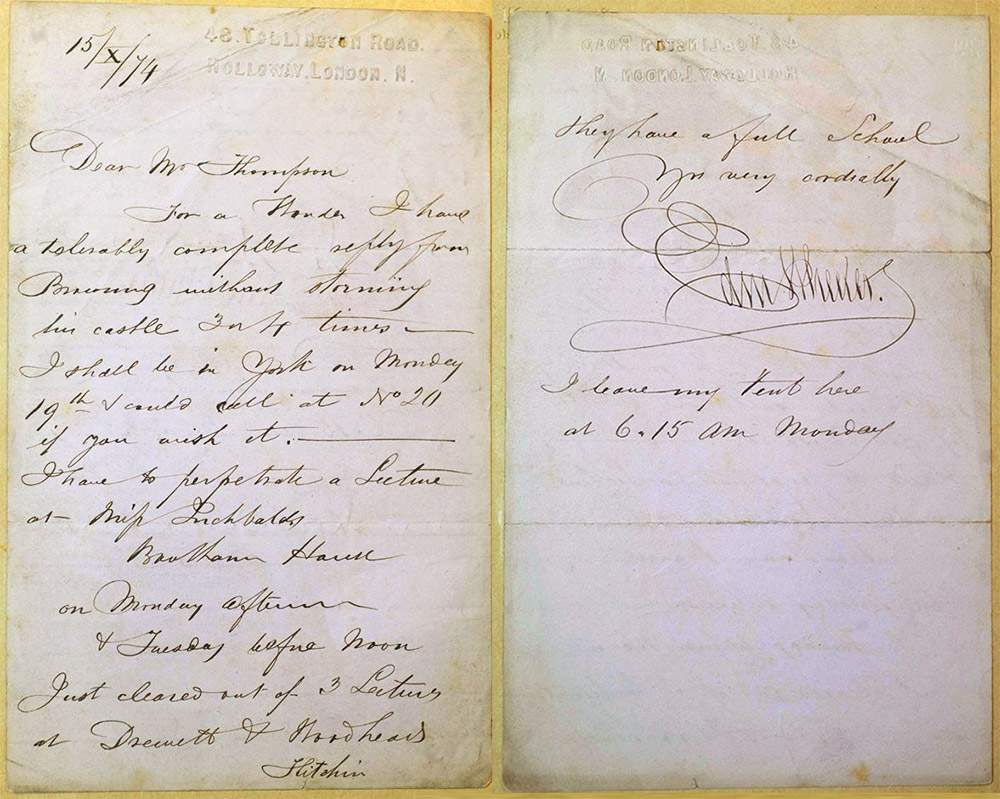
Figure 10B.
A letter from Edmund Wheeler, dated October 15, 1874 to a Mr. Thompson of York. In the letter, Wheeler mentions two upcoming lectures in York (at Anne Inchbald’s girl’s school, Bootham House), and three previous lectures at the school of Joseph Drewett and Cranston Woodhead in Hitchin. Courtesy of John Goodman.
Wheeler the optician
Coincident with his lecturing, Wheeler initiated a business of producing microscopes, slides, and other optical equipment and supplies. In Wheeler’s 1880, 8th List of Microscopic Objects, he claimed “twenty-five years experience in the manufacture of microscopes and microscopic objectives, aided by his Son, who occupied for many years an important position in the Manufactory of Messrs. Smith and Beck”. That would give a starting date of 1855. Edmund Jr. turned 19 that year. The 1861 census described the son as a “working optician”, and evidence described below suggests that Edmund Jr. worked for Smith and Beck in that year. A likely scenario has the son working as a lens-maker with Smith and Beck from the mid-1850s (and, possibly earlier, as an apprentice), then joining with his father during the early 1860s to produce their own lenses, etc. It is also possible that the father may have begun making slides, lenses, etc. for commercial sales during the 1850s.
The earliest known published reference for this phase of Wheeler’s life is late 1862, when he produced a leaflet giving points to consider in choosing an optical instrument (Figure 11). The authoritative tone of the advertisement implies considerable experience with these topics.

Figure 11.
The earliest identified microscope-related advertisement by Edmund Wheeler, from “The British Friend”, 1862. Later catalogues indicated that Wheeler began working on optical instruments in about 1855.
Wheeler did not submit items under his own name to the 1862 London International Exhibition, suggesting that his business was not yet fully developed. However, he later implied involvement in the Exhibition, by illustrating an 1862 medal with his products in the 1876, 7th Edition of his List of Microscope Objects. He went further in his 1880 List of Microscopic Objects, specifically stating that he had obtained an 1862 prize for the excellent quality and reasonable price of his objectives. Some clarification is to be found in his only extant Microscope Catalogue, the third edition from 1869 (figure 12). There, he declared that 1862 Medals were awarded to another un-named optician(s) who had exhibited his objectives. A possibility is that, since his son had worked with Smith and Beck, Edmund may have felt that the son had contributed greatly to the latter’s Prize Medal.
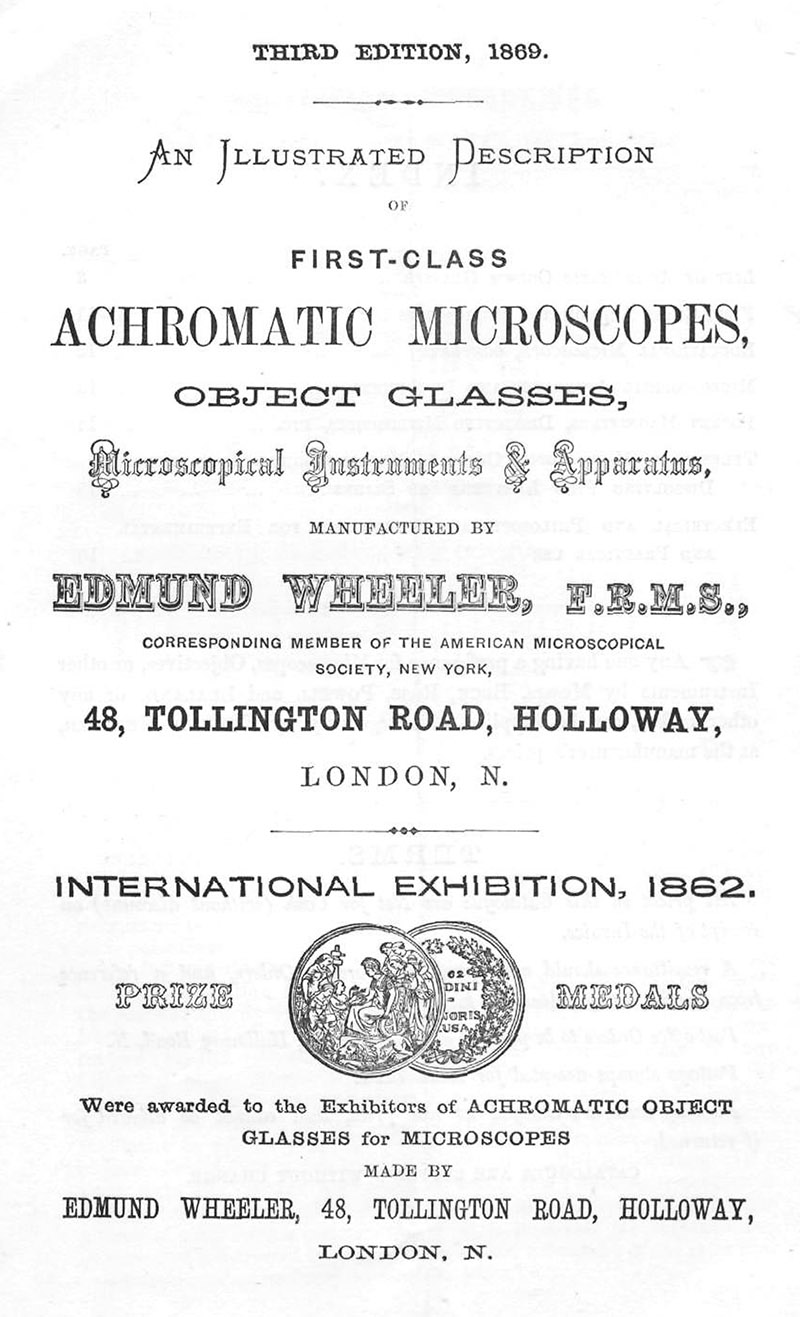
Figure 12.
Cover of Edmund Wheeler’s 1869, third edition catalogue of microscopes and lenses.
Wheeler had legitimate claims to other awards. Over the next two decades he gained four First-Class Medals and Diplomas for the excellence of his microscopic preparations: in 1866 at the Yorkshire Fine Art and Industrial Exhibition, in 1870 at the Royal Cornwall Polytechnic Society, in 1876 at the International Centennial Exhibition, Philadelphia and, in 1878, at the Paris Universal Exhibition.
Wheeler evidently had developed a serious business in optical instruments and supplies by 1863, as an advertisement issued that year (Figure 8, above) claimed that he had 10,000 prepared microscope slides in stock, along with various types of microscopes, objective lenses, telescopes, and binoculars. His business had become sufficiently well recognized by 1863 that the Goldsmiths', Jewellers', Silversmiths', Watchmakers', Opticians', and Cutlers’ Directory for London, etc. included the listing, “Wheeler Edmund J. (sic) achromatic object glasses for microscopes, 48 Tollington-road, Holloway, N.” Considering his evidently large stock of slides and instruments, Wheeler’s ca.1862 move to Tollington Road may been prompted by the need for a spacious showroom to support his burgeoning business.
Edmund was elected to be a Fellow of the Royal Astronomical Society on March 8, 1861. He joined the Microscopical Society of London three years later, on May 11, 1864. He sometimes adopted the initials FRAS after his name and, among other likely benefits, connections made through these societies would have provided him with lecturing opportunities.
The 1868, 4th edition of The Microscope and Its Revelations, William Carpenter included the accolade that “the half-inch and quarter-inch constructed by (Wheeler) … are at the same time excellent in quality and very moderate in price”. More generally Carpenter also wrote, “Microscopes suited to Educational purposes, and corresponding more or less closely in price and general arrangement with the above, are made by Messrs. Baker, Collins, Highley, Steward, Wheeler, and other Opticians in London, and by Messrs. Parkes, in Birmingham. In most of these the workmanship is superior, but the variety of Powers and the number of Accessories are less. … The fo������������llowing are known to the Author as furnishing Student's Microscopes of this class, at prices ranging from five to seven guineas, which can be recommended as combining really good workmanship in their mechanical portion, with an optical performance adequate to all ordinary requirements: Messrs. Baker, Collins, Highley, How, and Wheeler. The 1/4th inch Objective of 70o made by the last-named Optician…for his five-guinea Student's Microscope, may be specially mentioned as bringing out the markings of the Podura-scale with a force and clearness that show this objective to be eminently adapted for Physiological purposes, although it can scarcely resolve the easiest of the Diatom-tests… Several other Opticians may be named as makers of Microscopes which deserve to rank in the First Class, on account both of their Optical and of their Mechanical excellence; such are the instruments constructed by Messrs. Baker, Collins, Crouch, Dallmeyer, Ladd, Pillischer, Swift, and Wheeler. These are for the most part copied, with more or less of modification in detail, from the models either of Mr. Ross, or of Messrs. Smith and Beck; very little that is original having been introduced. The prices of these instruments, however, are usually from 10 to 20 per cent less than those of the corresponding instruments of the original constructors; and excepting with the highest powers, little inferiority would be discovered in their performance, save by the most critical judges”.
Jabez Hogg wrote in his 1871 edition The Microscope: Its History, Construction, and Application, “Mr. E. Wheeler’s (Holloway) well-made instruments deserve commendation and notice; they are carefully finished and quite up to the modern standard”. See Figures 8 and 9 (above) for signed examples of his microscopes and lenses.
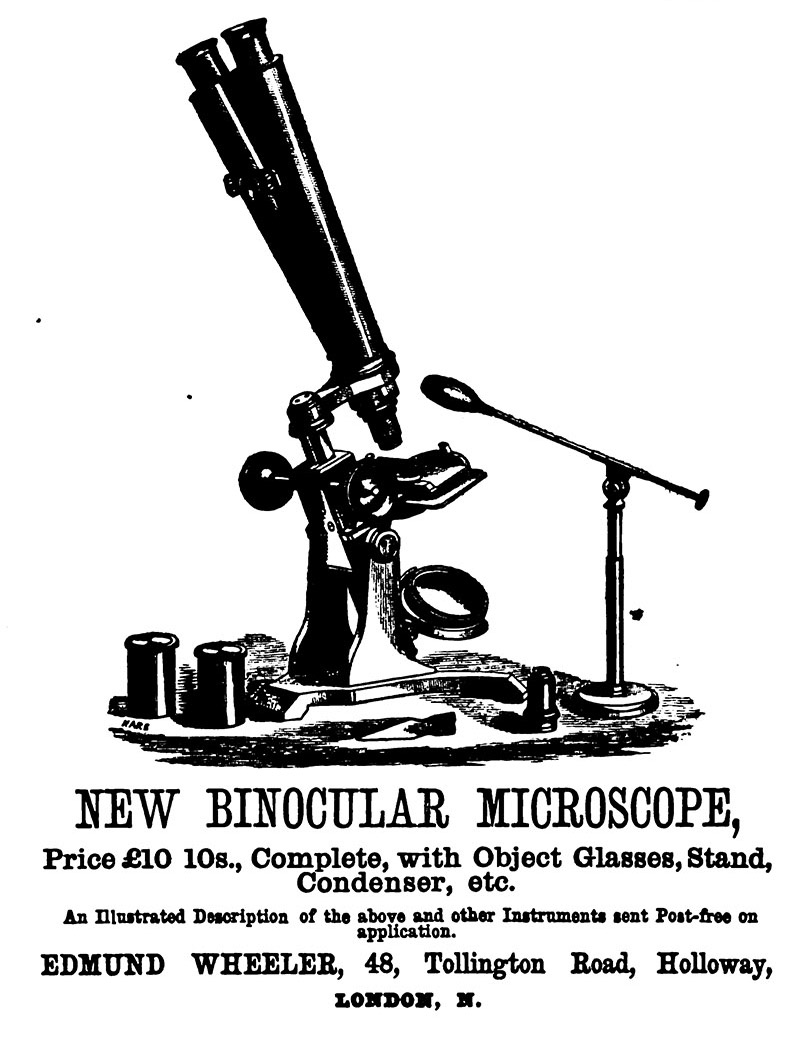
Figure 13.
An 1865 advertisement, from “The Intellectual Observer”.
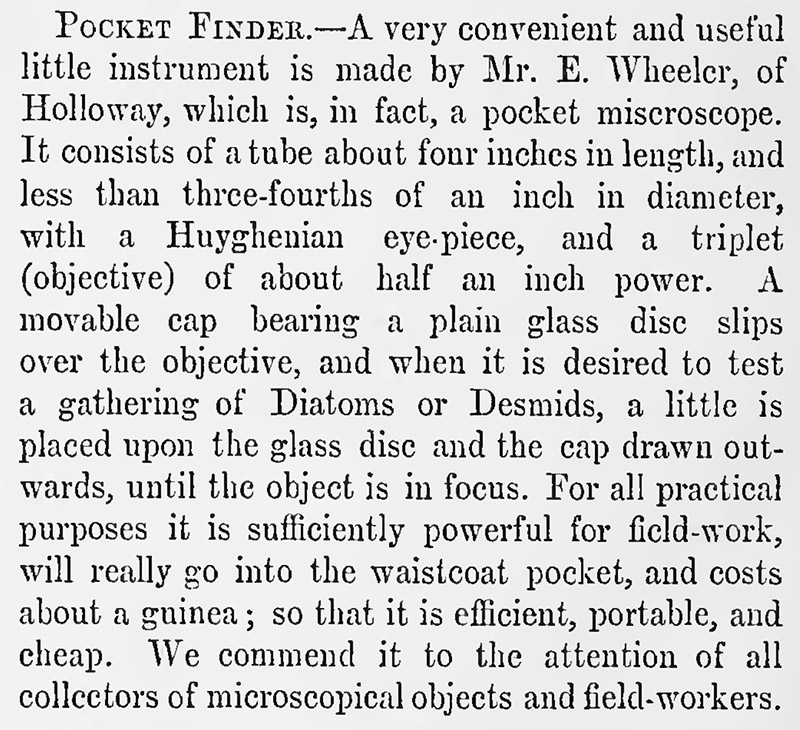
Figure 14.
An 1868 announcement from “Hardwicke’s Science-Gossip”, on Wheeler’s Pocket Finder microscope.
Wheeler’s 1869 microscope catalogue ran to 16 pages (Figure 15). It illustrated 4 “first class” and one “educational” stand, and described a dissecting stand, accessories. and a variety of implements. The binocular version of his “A” stand, with some accessories, cost £32, but the full range of accessories he offered would have added a further £65. By comparison, the top-of-the-range First Class binocular microscope issued by Smith, Beck and Beck at the time cost £125. Wheeler’s cased low-end “Improved Educational Model E” cost only £5 5/-, with additional accessories suited to student use adding a further £5 1/-. Wheeler claimed consistently that, like-for-like, his microscopes undercut others and that his “Educational Model” was the best ever produced at the price. The 1869 Catalogue is also interesting because it lists 15 additional catalogues that covered a wide range of philosophical instruments, including microscopic objects and supplies, telescopes, binoculars, barometers, thermometers, magic lanterns and slides, surveying instruments, steam and electric instruments, eye glasses, and much more. While it seems unlikely that Wheeler would have produced all those products, or even maintained a complete stock, he evidently had ready access to those supplies from specialized trade manufacturers. Based on numerous historical documents, we can be certain that, at the very least, Wheeler and his assistants constructed the optical components of their microscopes and telescopes.
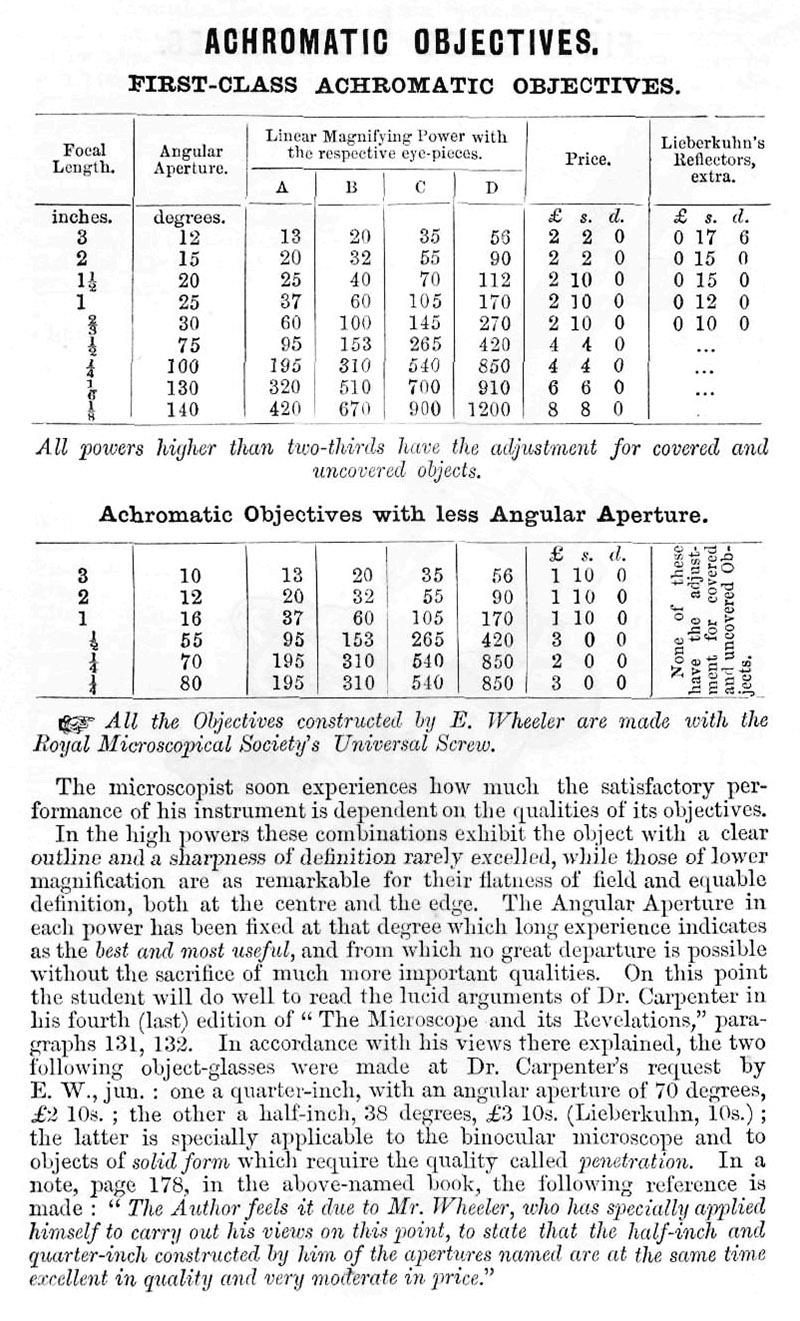
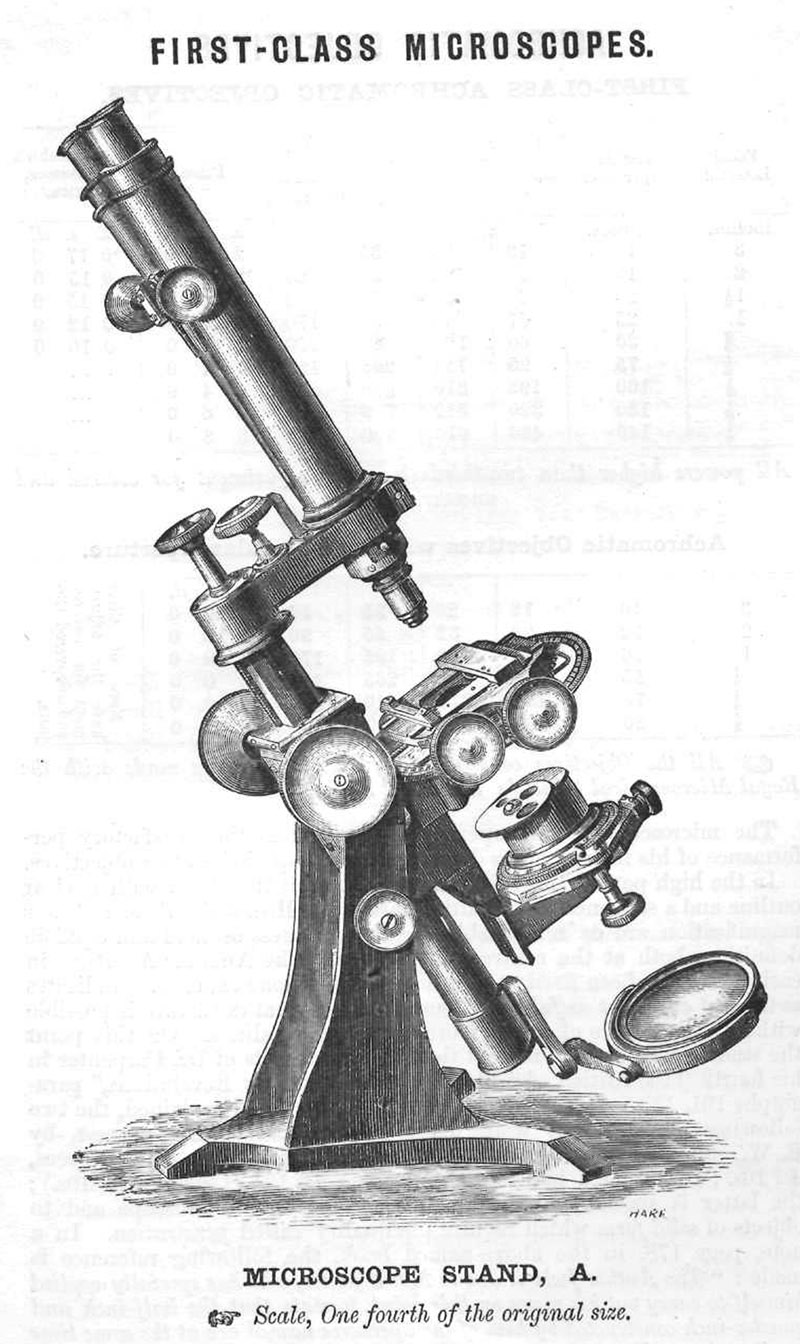
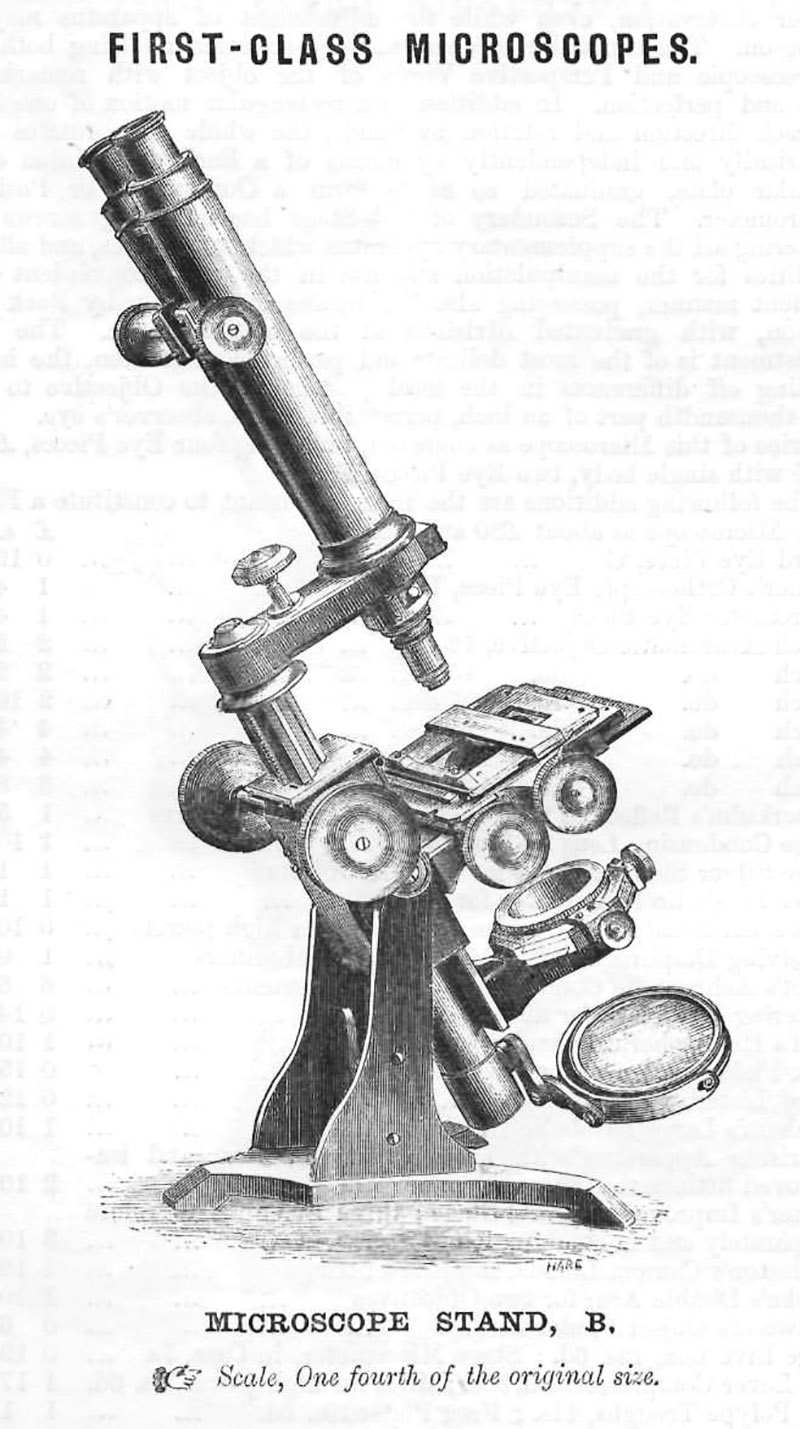
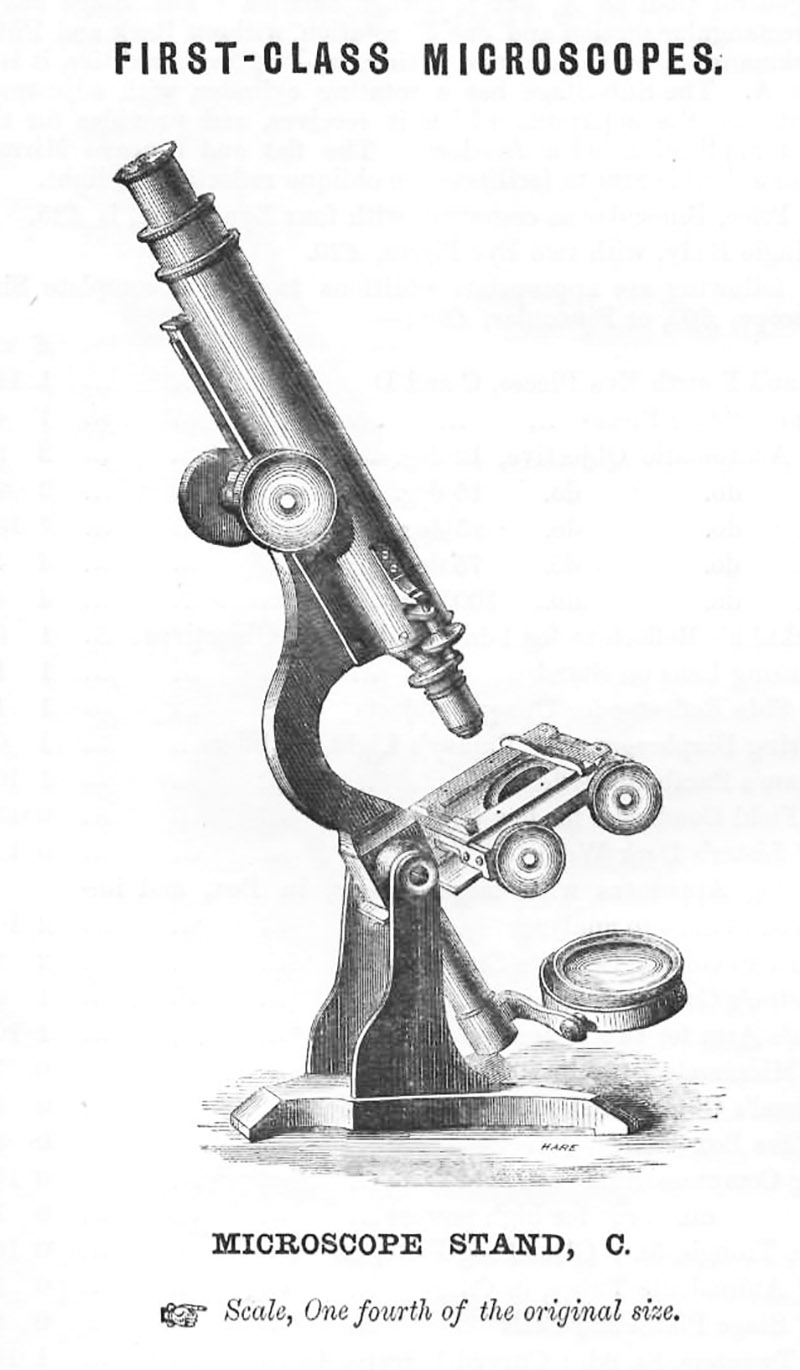

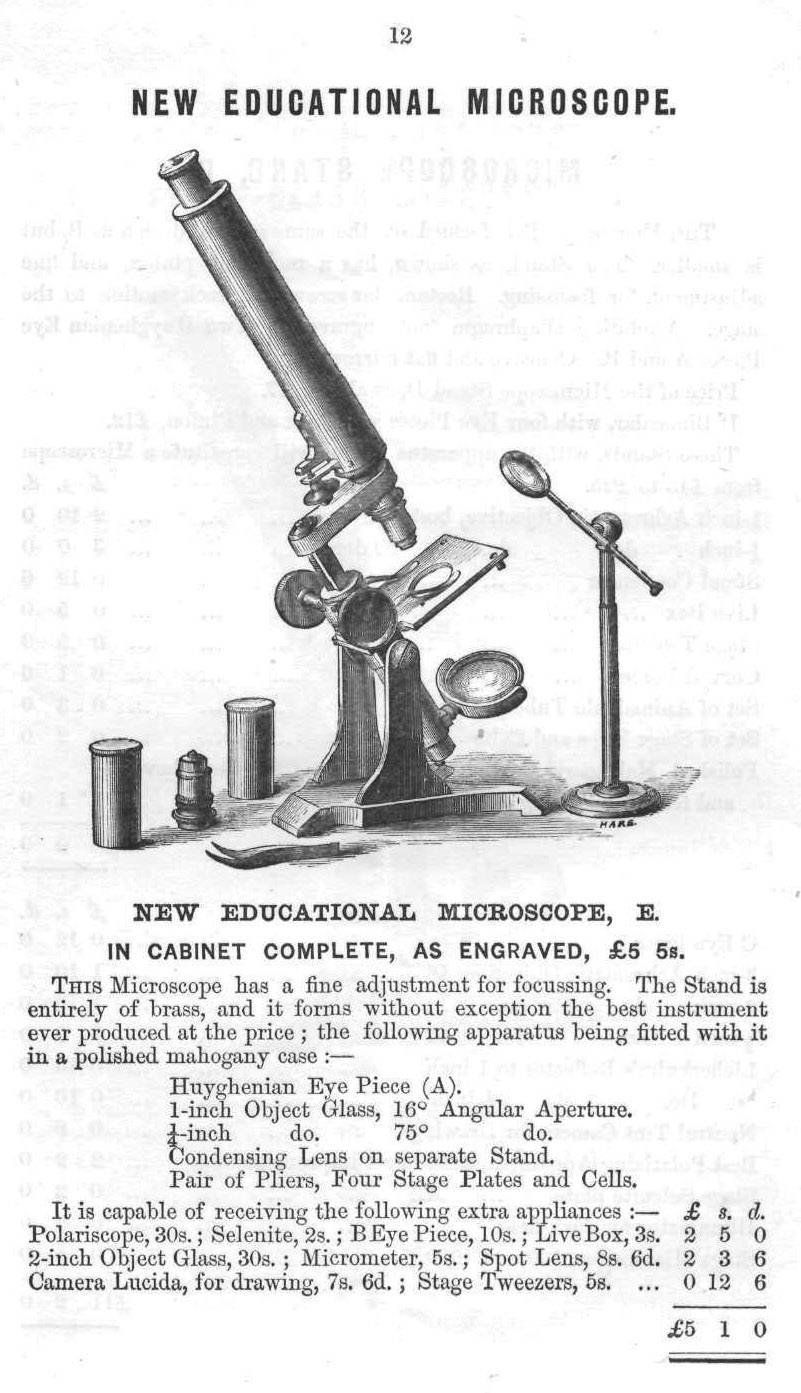
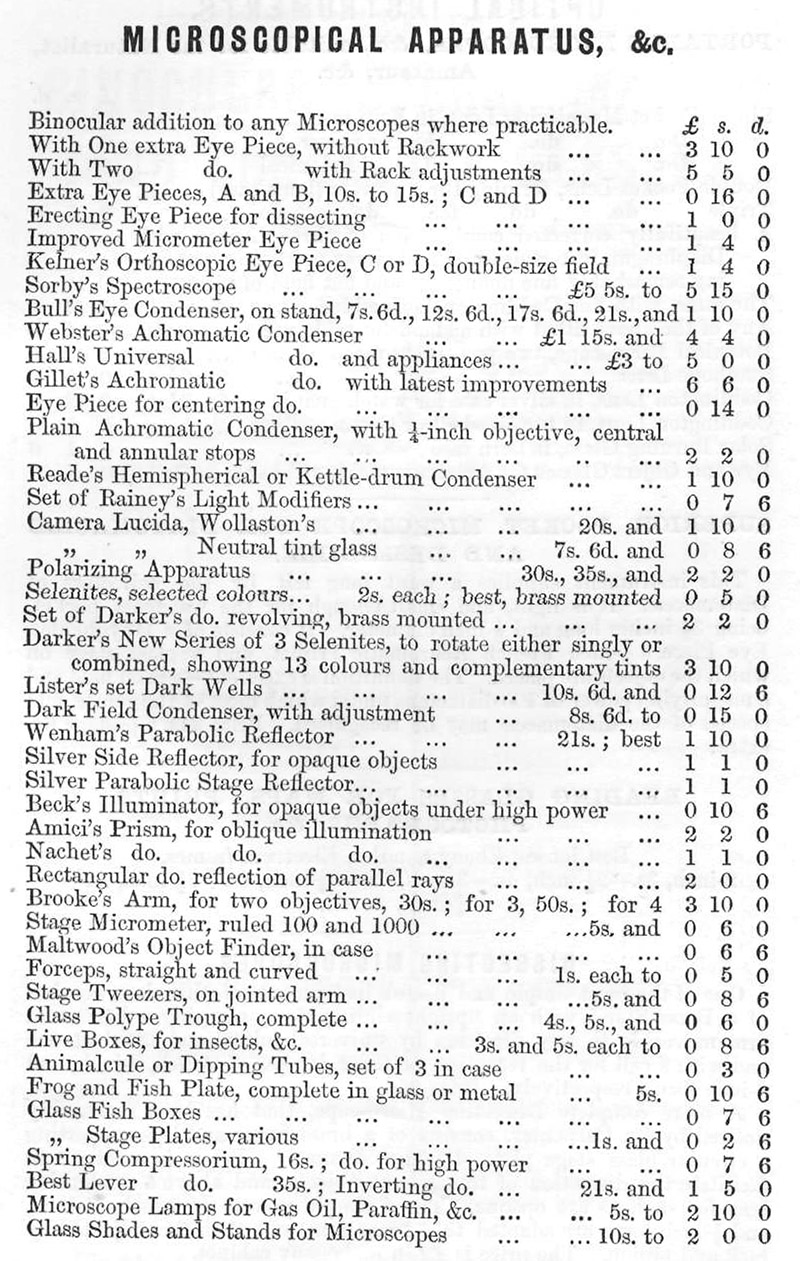
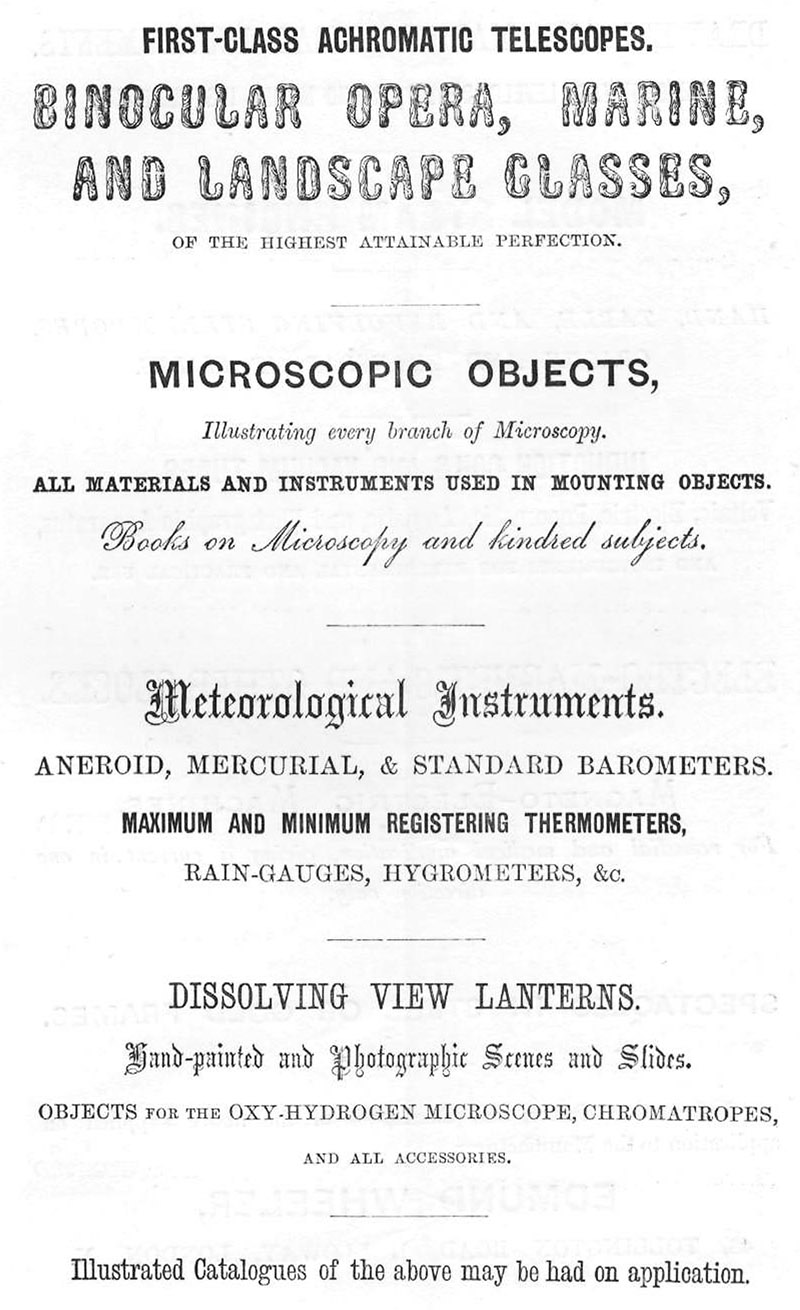
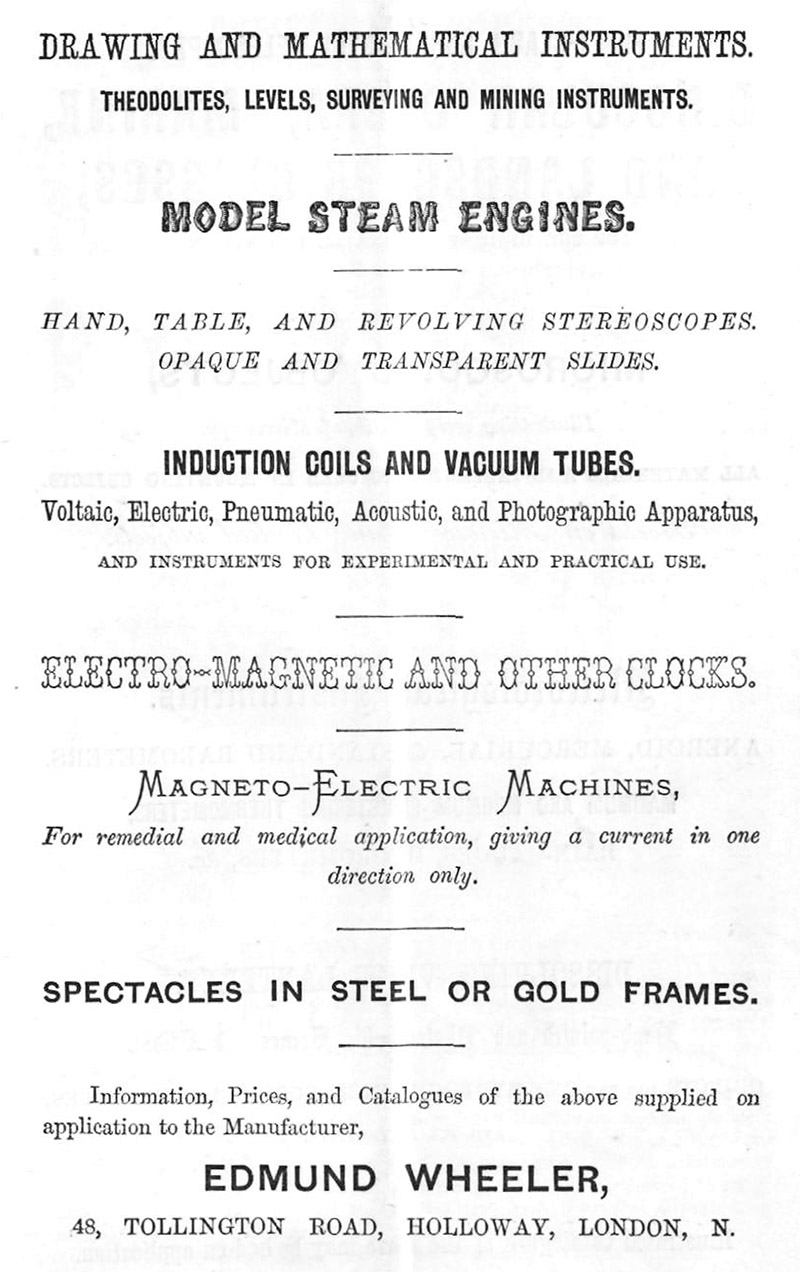
Figure 15.
Excerpts from Edmund Wheeler’s 1869 microscope catalogue. Note that he credited his son, Edmund Junior, with producing objective lenses for Dr. Carpenter.
Wheeler kept abreast of developments in materials and in optical design. In 1864, he advertised a telescope in aluminum, claiming a reduction of a factor of four in weight. Aluminum first came to public attention as a bright silvery metal at the Paris 1855 Exhibition. Thomas Ross showed an aluminum telescope at the 1862 London Exhibition, where he claimed a more realistic factor of two reduction in weight (for simply replacing the brass by aluminum). Negretti and Zambra (ca. 1870) stated that they had used aluminum in the frame of one of their field glasses on display at the 1862 Exhibition and were offering aluminum field, opera and telescopes in their ca. 1870 catalogue. Thus, in using aluminum by 1864, Wheeler was very much to the forefront of manufacturing.
As a member of the Royal Astronomical Society, Wheeler was personally acquainted with many of the top astronomers of his time. An 1865 letter to Sir John Herschel is particularly insightful. Wheeler reminded Herschel, by way of introduction, that he had visited Herschel’s estate at Collingwood in 1861. Wheeler then solicited new lecturing opportunities, even offering to present lectures for free, commenting, “We are working very hard; but to acquire a name & fame is no easy task”. He next explained how most of his time was devoted to those lecture programs, although the business continued to produce first class lenses and instruments. Indeed, his son had recently turned his attention to improving telescope objectives and they were requesting advice on how best to construct a lens of a type which had been described by Herschel. In addition, Wheeler offered to send one of his telescopes as a gift for Herschel’s son. Those were days of very fast post and immediate responses, and Wheeler wrote again to Herschel two days later, thanking him for his advice on lens design and for providing a reference to a lecturing opportunity. The promised telescope accompanied that second letter. Clearly Wheeler lost no opportunity to advance his business!
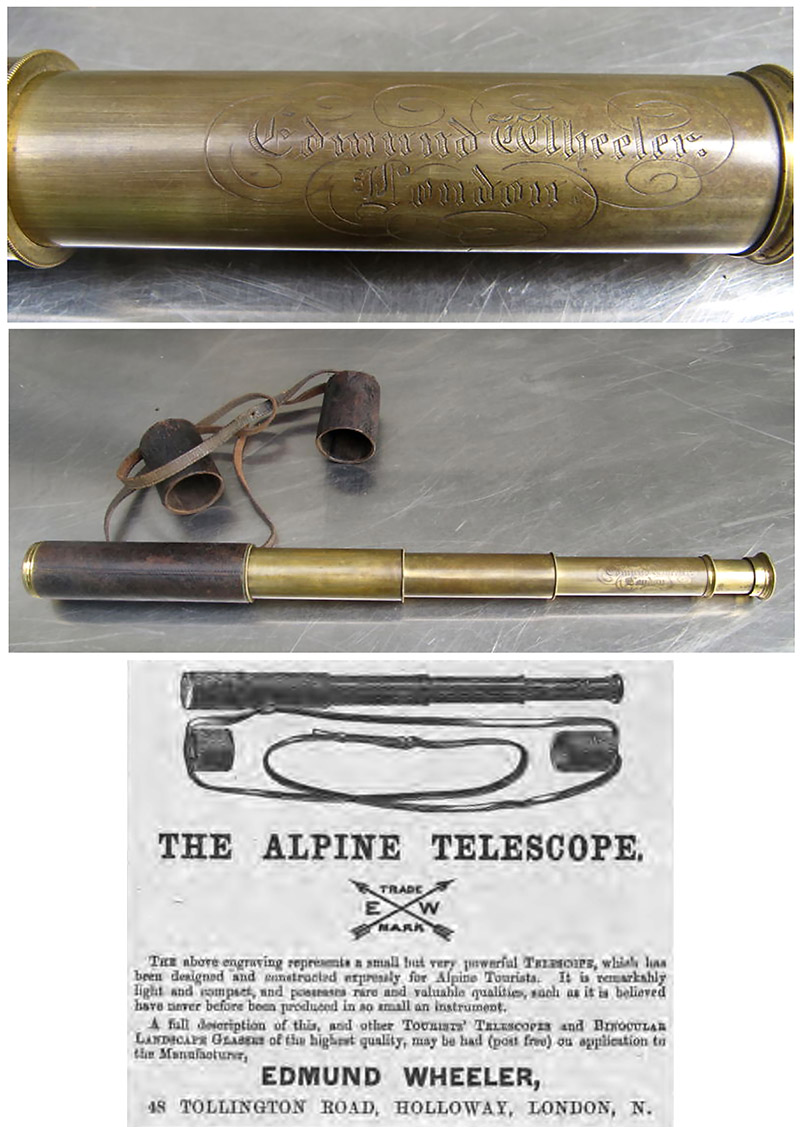
Figure 16.
A surviving telescope that was manufactured by Edmund Wheeler, and an 1866 advertisement for that model, from “The Alpine Journal”. Images of the telescope adapted from an on-line auction site for nonprofit, educational purposes.
An important form of advertising at the time was to exhibit at society soirees, where large audiences could assess the latest offerings. At the 1864 Dress Soiree of the Microscopical Society of London, Wheeler showed, “Twenty-one microscopes, and an elaborate display of objects, with some light well-made cases for the convenience of carrying a quantity of objects with safety. These comprised some respectable instruments at a very low cost, with others of higher pretensions; and his first-class binocular, with his improved achromatic objectives, made expressly for binocular use, a new goniometer stage, and the modern appliances for special illumination. The objects were elegantly displayed, embracing an extensive series in almost every branch of microscopy; the most enviable, perhaps, being his grouped and symmetrical selections of diatoms, both opaque and transparent; whole insects, orchidaceous and other vegetable structures, and anatomical preparations”.
The 1864 Soiree of the Apothecaries’ Society featured not only microscopes and slides by Wheeler, but also, “The Messrs. Wheeler showed various experiments illustrating the allotropic conditions of several elements. They also electrolysed water, making use of carbon poles; and showed that when these were employed carbonic acid was obtained at the negative pole in place of oxygen. Another experiment illustrated the bleaching effects of nascent hydrogen, the gas, at the moment of disengagement, decolorising a solution of indigo, but having no effect on the same solution when passed into a wash bottle containing it. On Wednesday morning, when the microscopical exhibition was visited by a large number of ladies, the same gentlemen made a series of brilliant experiments with twenty-four cells of a carbon battery of their own construction. With this battery they produced a powerful electric light, and showed the arc of the thallium flame on the screen. Iron and zinc were burnt with ease by means of the battery. They also exhibited the magnesium light, and showed beautiful experiments illustrating the fluorescent property of a solution of sulphate of quinine”.
The combination of travelling for lectures coupled with the production of optical instruments and slides made for a demanding life. Frederic Enock, a nephew who worked for Wheeler, wrote, “When not engaged in lecturing, Edmund Wheeler was occupied in optical work, the making of microscopes and lenses, incorporating with it the preparing of objects for the microscope… After a six weeks' ‘Lecturing Spree’ as he called it, he would come home and in five minutes would be in his ‘den’ working with all his might, and so keep on till the midnight oil was burned.”
He did have assistance with his optical work, however, initially from his son and daughters, and later from other helpers. As noted above, Wheeler’s 1865 letter to Herschel stated that his son was actively producing their microscopes, lenses, and telescopes. As evidence of the rest of the family’s involvement, a review of the 1864 Annual Soiree of the Southampton Microscopical Society revealed that his slides “have all been prepared and mounted by himself and the other members of his own family, his sons (sic) and his daughters”. However, daughter Sarah Ann died of tuberculosis in August, 1863. The son, Edmund Jr., and the remaining daughter, Sophia, moved to Brighton around 1870. Sophia died there in 1871, also of tuberculosis. It is possible that the son continued to provide his father with slides and instruments from his new home. That move may have been facilitated by Edmund Sr. taking on Frederic Enock as an assistant. Enock was a son of Caroline’s brother Robert. Additional help came from Ernest Hinton, who later advertised that he worked for 20 years with Wheeler, indicating that Hinton began working there about 1864. Hinton’s employment suggests that other, unknown assistants may have worked for Wheeler over the years. Nonetheless, Edmund Wheeler must have been an excellent manager because, in spite of his many absences, his business continually expanded as it improved the quality of its products.
Edmund Jr., who died in 1930, set up a photography studio in Brighton in 1870 and continued in that business for 40 years. Signed examples of his carte-de-visite and cabinet card portraits are relatively common nowadays.
Those photographic skills raise a question about one range of specimens featuring in Wheeler’s 1876 and 1880 catalogues, namely, microphotographs. He offered some 115 subjects in the 1876-80 period, named in printed script lettering on his characteristic white oval labels. Many, but not all, were common subjects that also featured in John B. Dancer’s, Alfred Reeves’, and John C. Stovin’s labeled slides (Figure 18). One or two carry Dancer’s signature, and Wheeler’s “Sturgeon’s Tablet” undoubtedly originated from Dancer. Yet, Wheeler must be classed as a microphotograph producer because some images contain his embedded name or initials (Figure 17). Additionally, in his 1876 catalogue, Wheeler offered to produce microphotographs from a plate or carte de visite at 18 shillings per dozen, indicating that he had either his own studio or one processing on his behalf (Figure 18). That offer was not included in the 1880 catalogue.
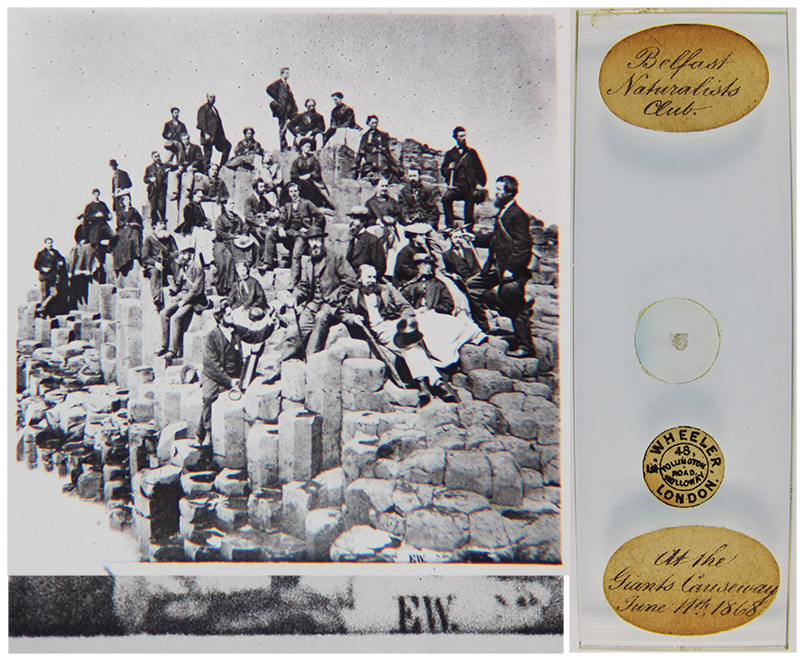
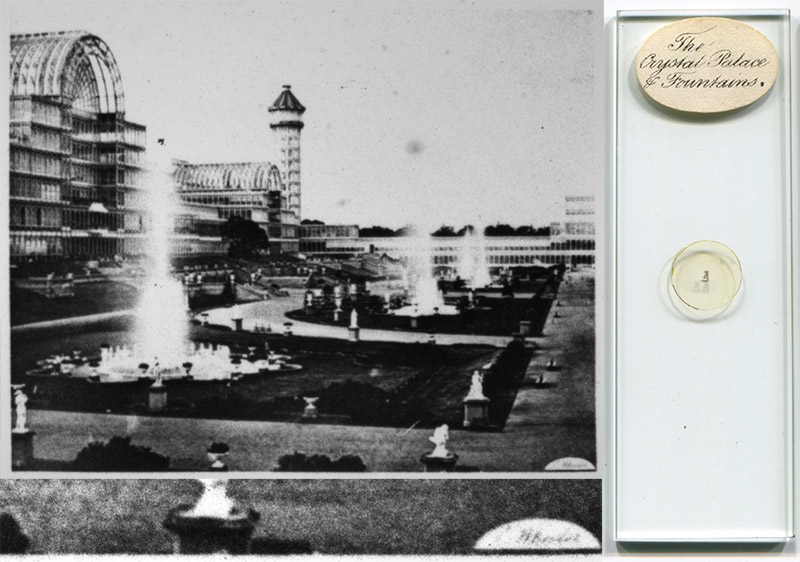
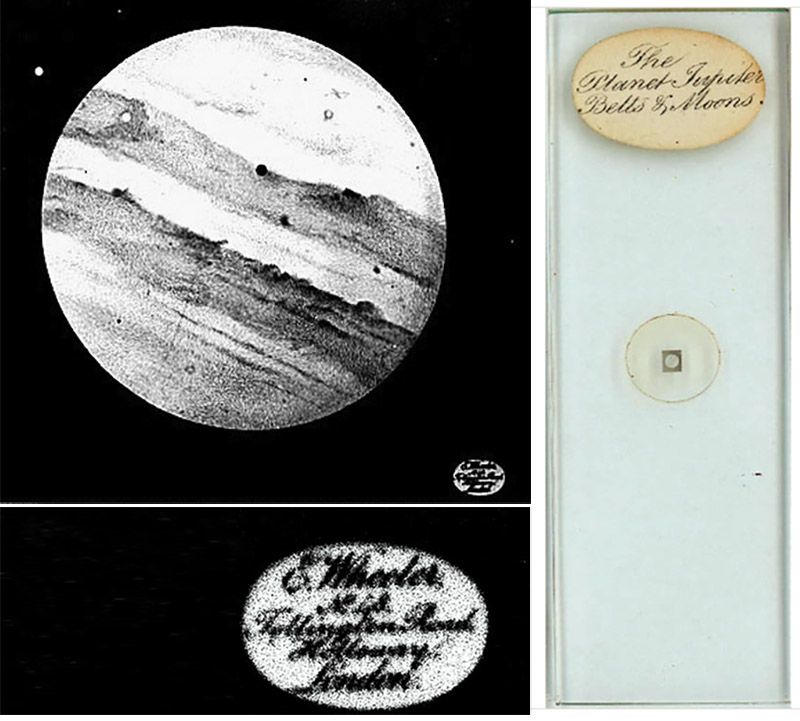
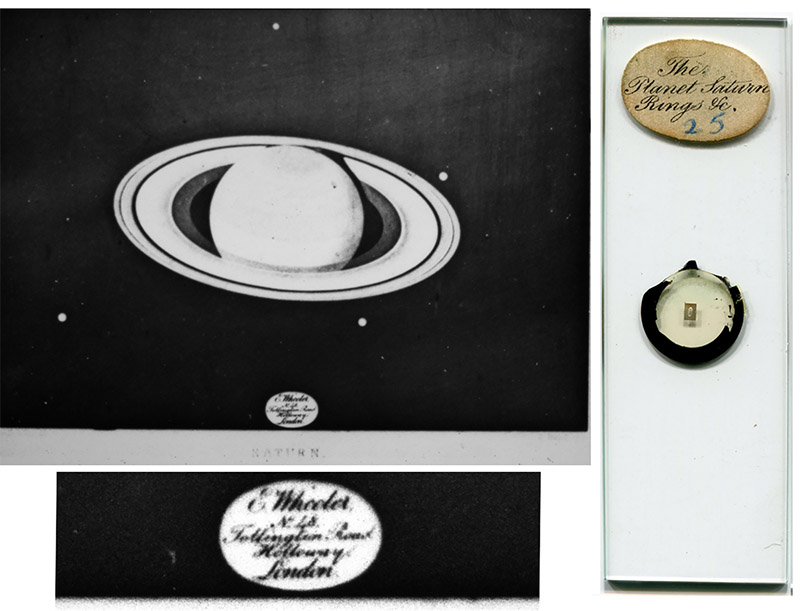
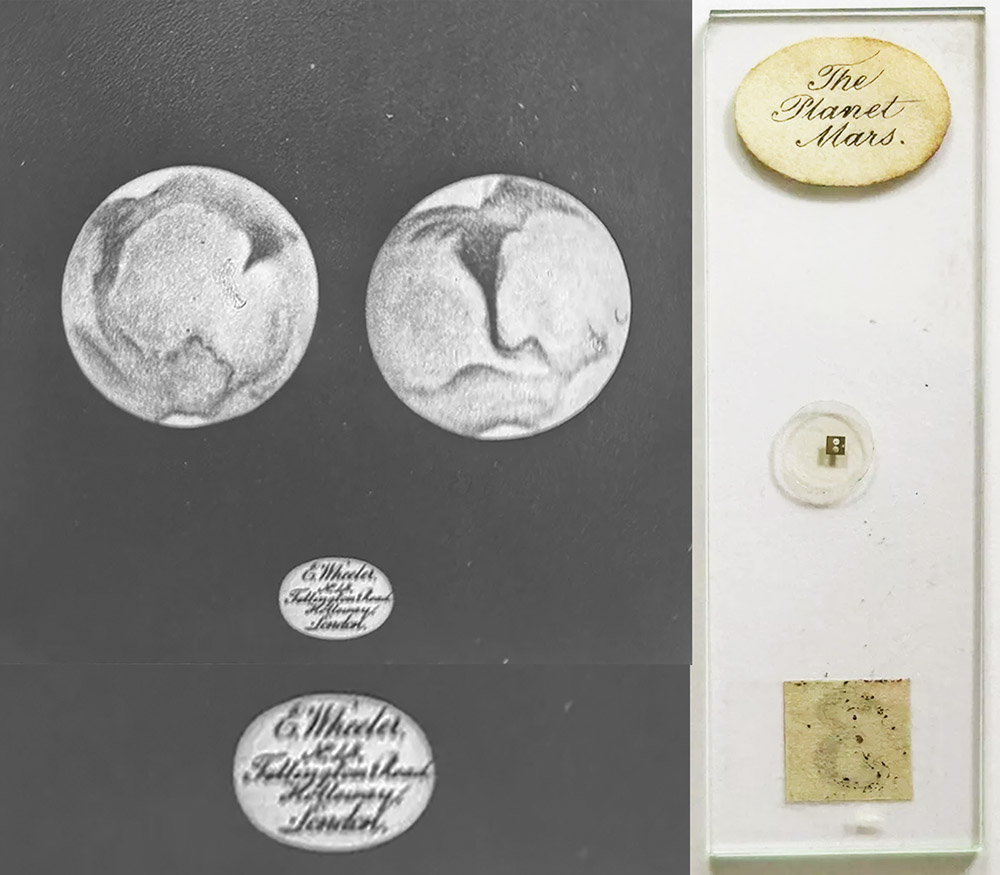
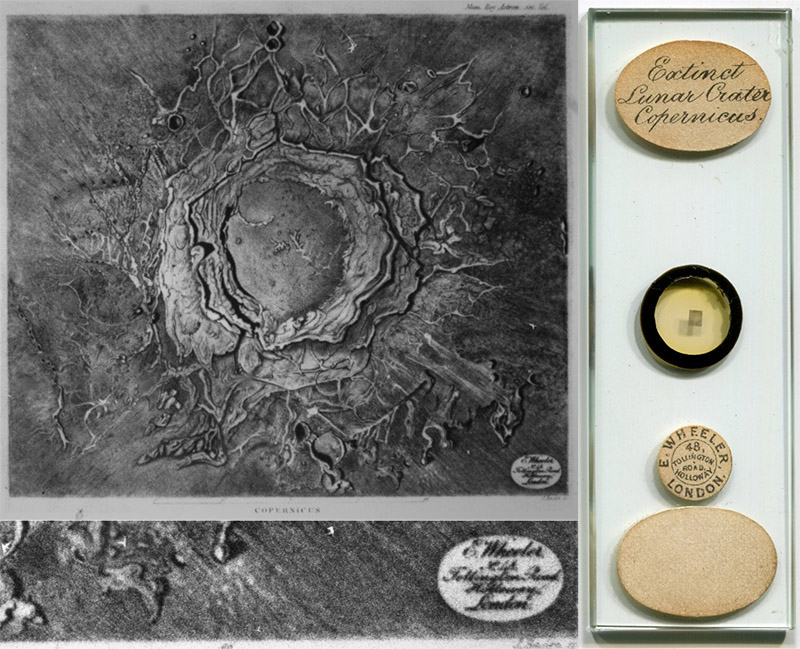
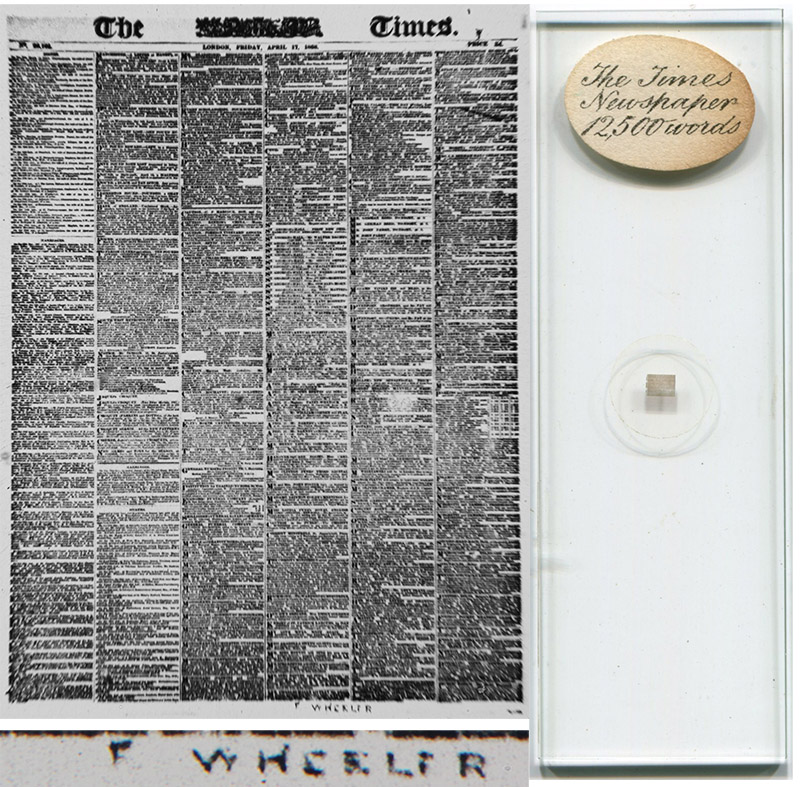
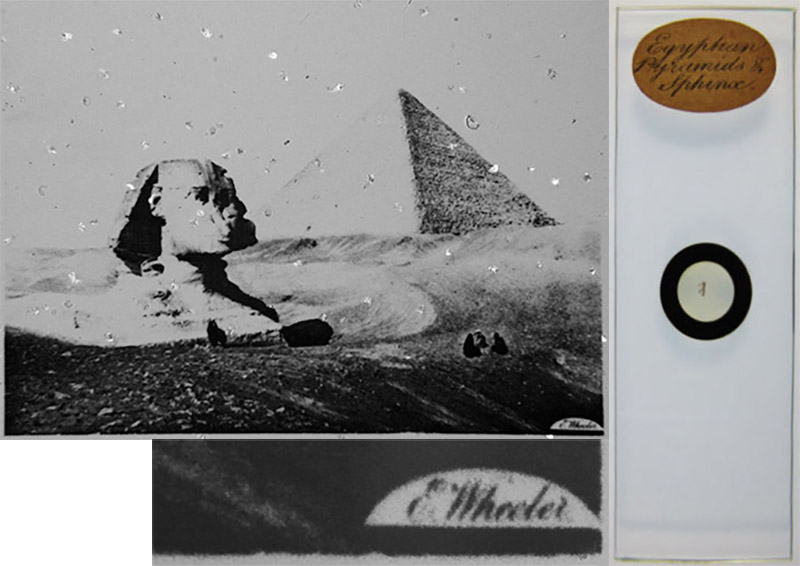
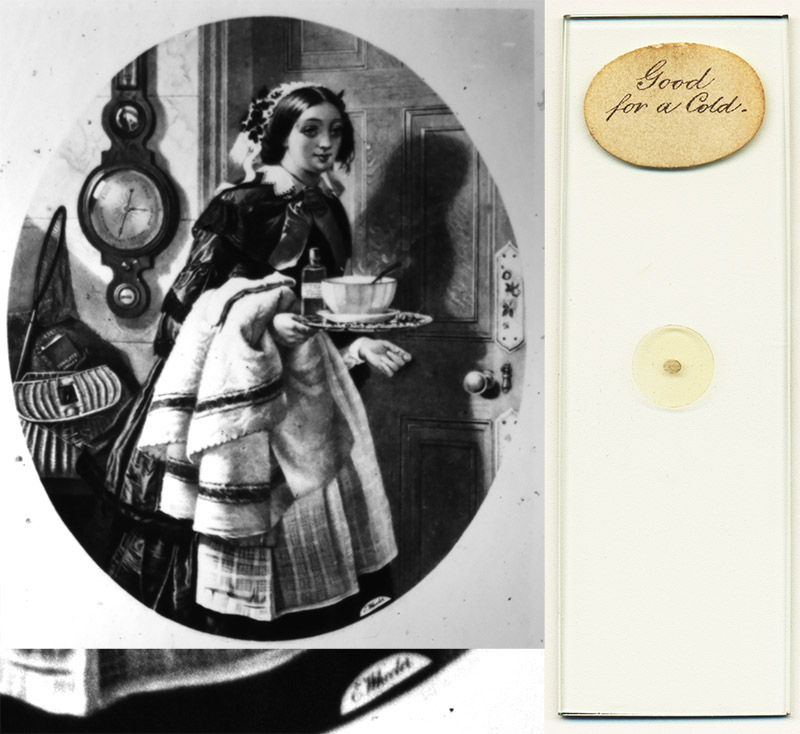
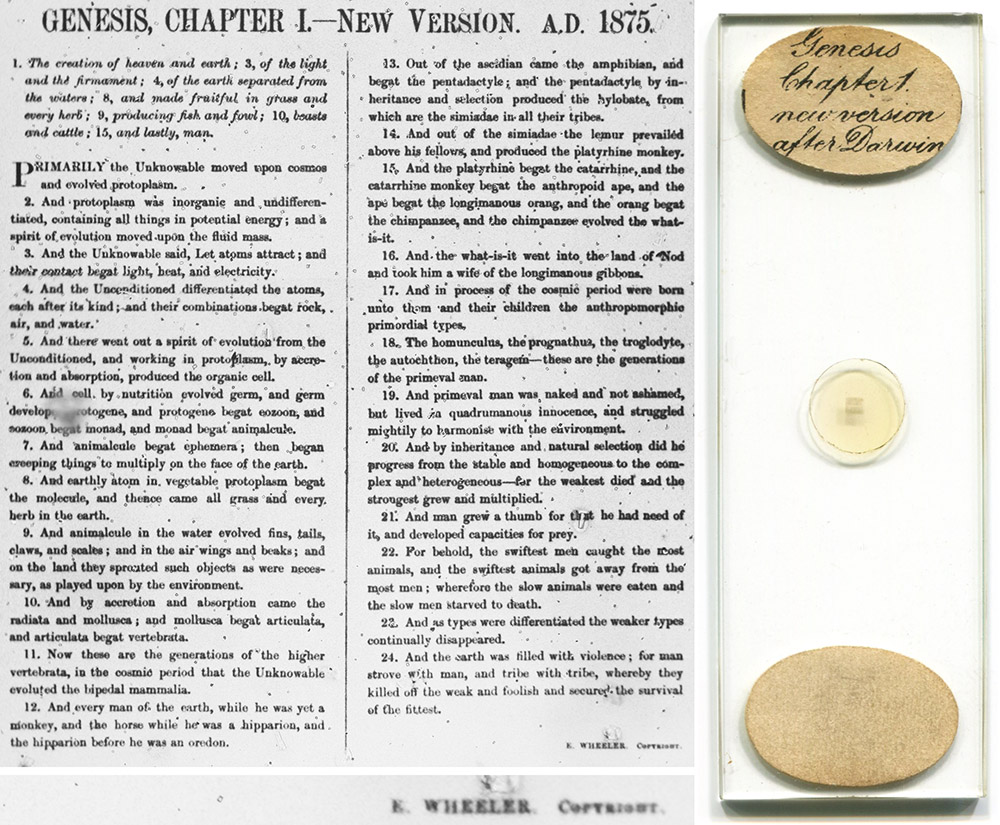
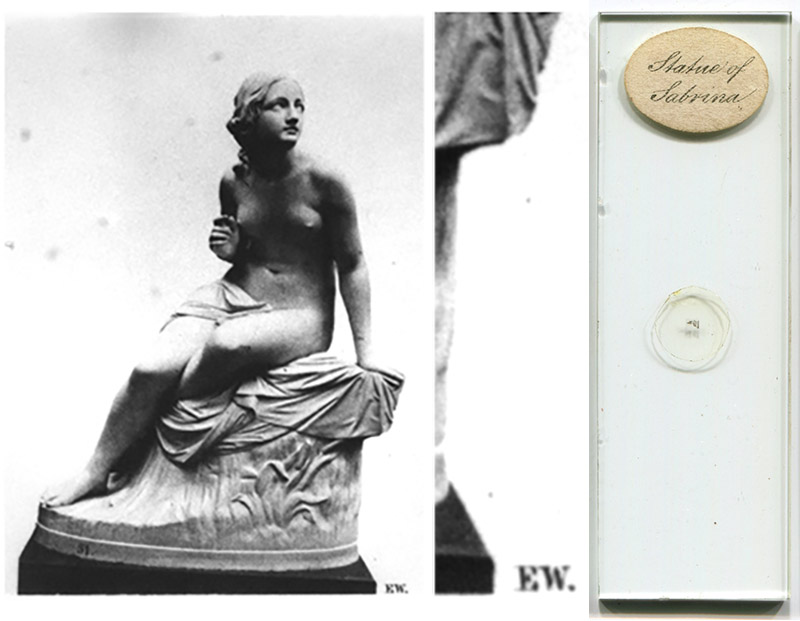
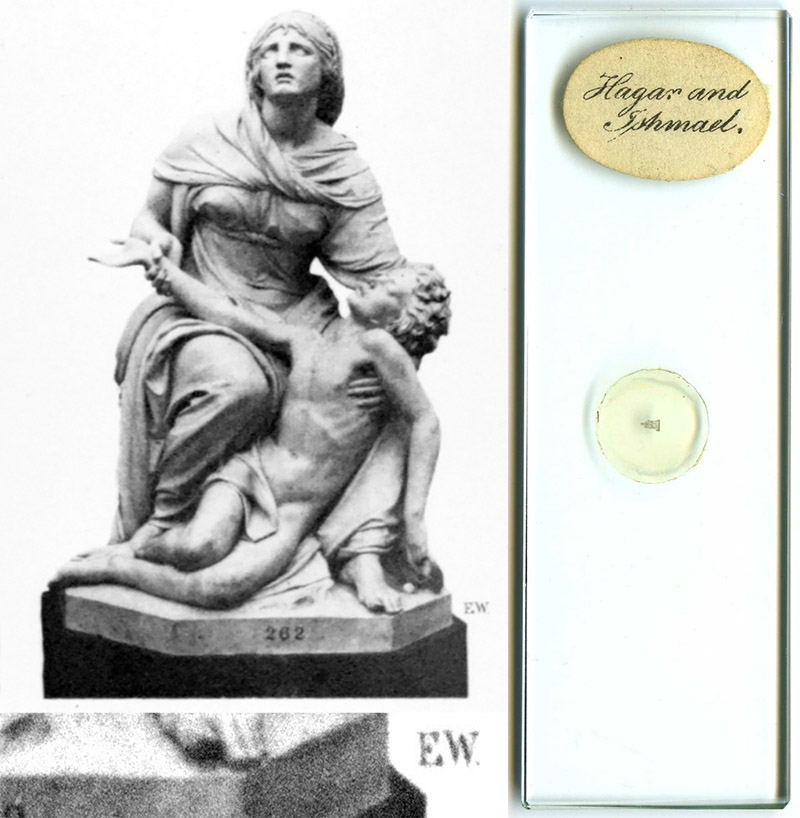
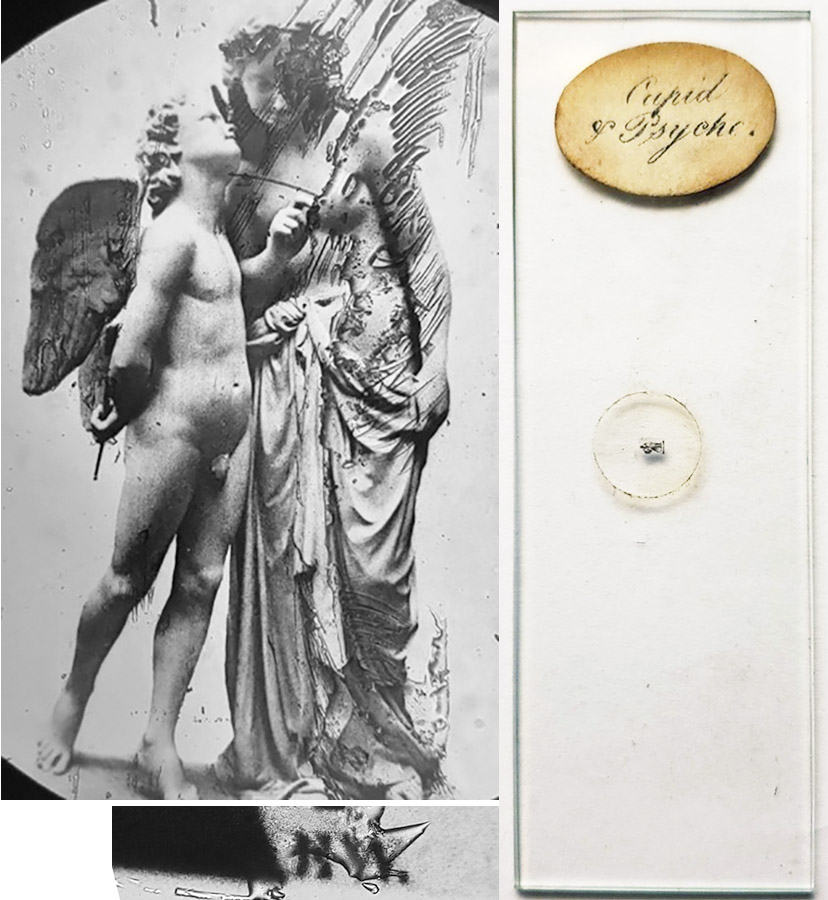
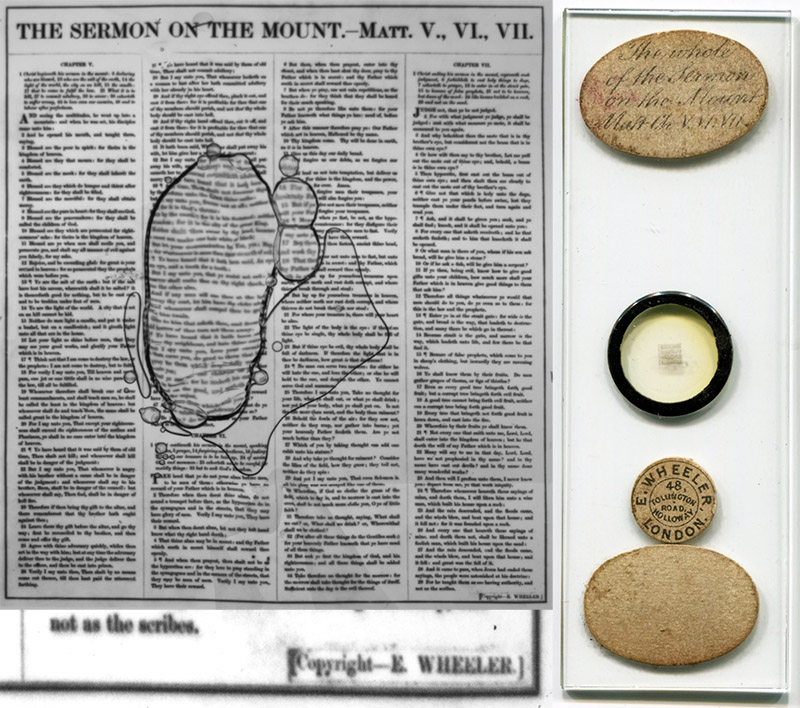
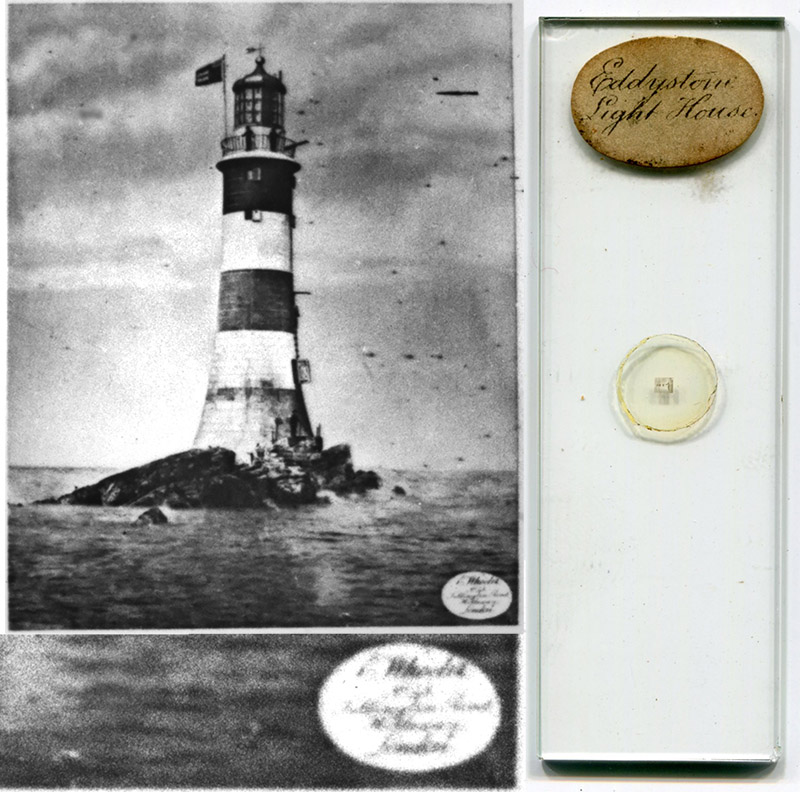
Figure 17.
Examples of microphotograph slides with Edmund Wheeler’s name or initials integrated into the image. These and other such slides demonstrate that Wheeler had a hand in producing the photographs. Several of these pictures are by courtesy of Richard Courtiour.
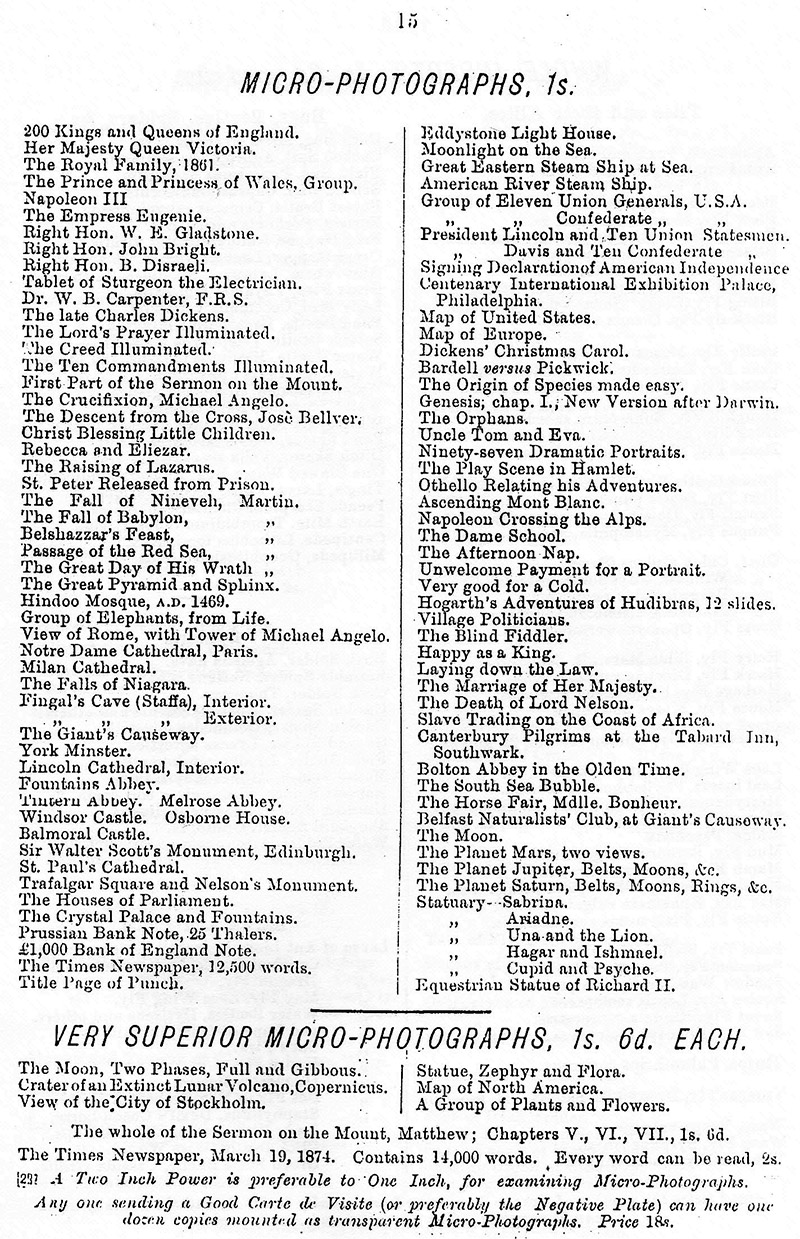
Figure 18.
Excerpt from Wheeler’s 1876 Catalogue of Microscopical Objects.
Wheeler is known to have bought in slides from other preparers. Enock wrote “These were not by any means all made by his own hands, for he gave an immense amount of labour in bringing before the scientific public the wonderful microscopic work of such men as the late Charles Fielding (sic) and his son Amos Topping, Rev. Thornton, Herr Maller (sic, i.e. Johann D. Möller), and others who contributed to his enormous stock of objects”. In addition, Wheeler’s advertisements cited productions by Karl Thiersch, William Webb, and Charles Elcock, and substantial similarities between slides sold by Wheeler and those made by John Barnett indicate that the latter man also produced for Wheeler. Moreover, Wheeler’s 1876 catalogue described that he had acquired the remaining slide stock of Charles Topping, after the latter’s 1874 death. The Station Zoologica in Naples, Italy reported that they sold 225 slides to Wheeler in February, 1882. Despite the costs of such purchases, they must have been profitable in the end.
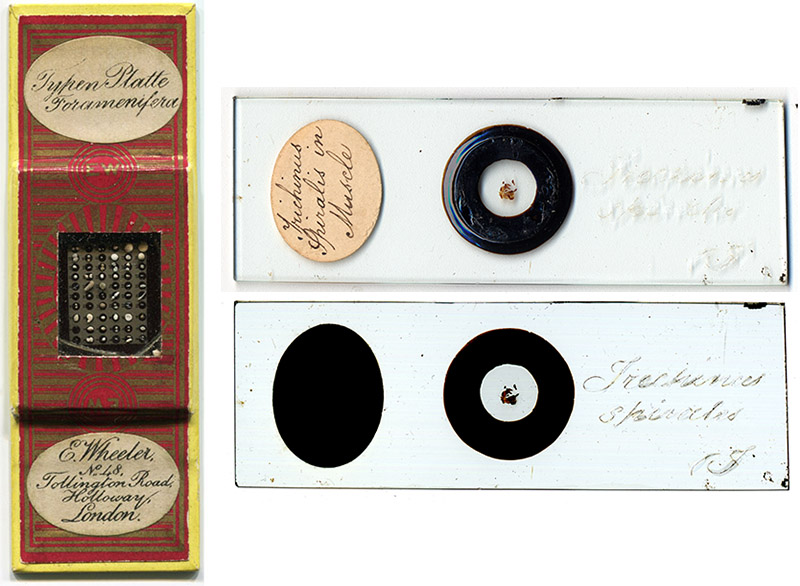
Figure 19.
Two slides that were retailed by Wheeler but produced by other professional makers. The phrase “typen platte” on the left slide implies production by Johan Möller, a known supplier of Wheeler’s. The right slide carries a label with Wheeler’s handwriting, and is engraved with Charles Topping’s initials and handwriting (imaged with reflected light to illustrate Wheeler’s label [top] and transmitted light to highlight the engraving [bottom]).
By 1880, Wheeler claimed to have 40,000 mounted specimens on hand, of some 3000 different named species. In 1883, that number had risen to 50,000 slides. At minimum retail prices of 1/- each, that represents a huge investment in stock. We sense that this was justified by a rapid turn-over, because he stressed to would-be customers that, when placing orders, they should name alternative species with which they would be satisfied. To facilitate the necessary turn-over, he placed direct advertisements in the UK and America (Figure 19).
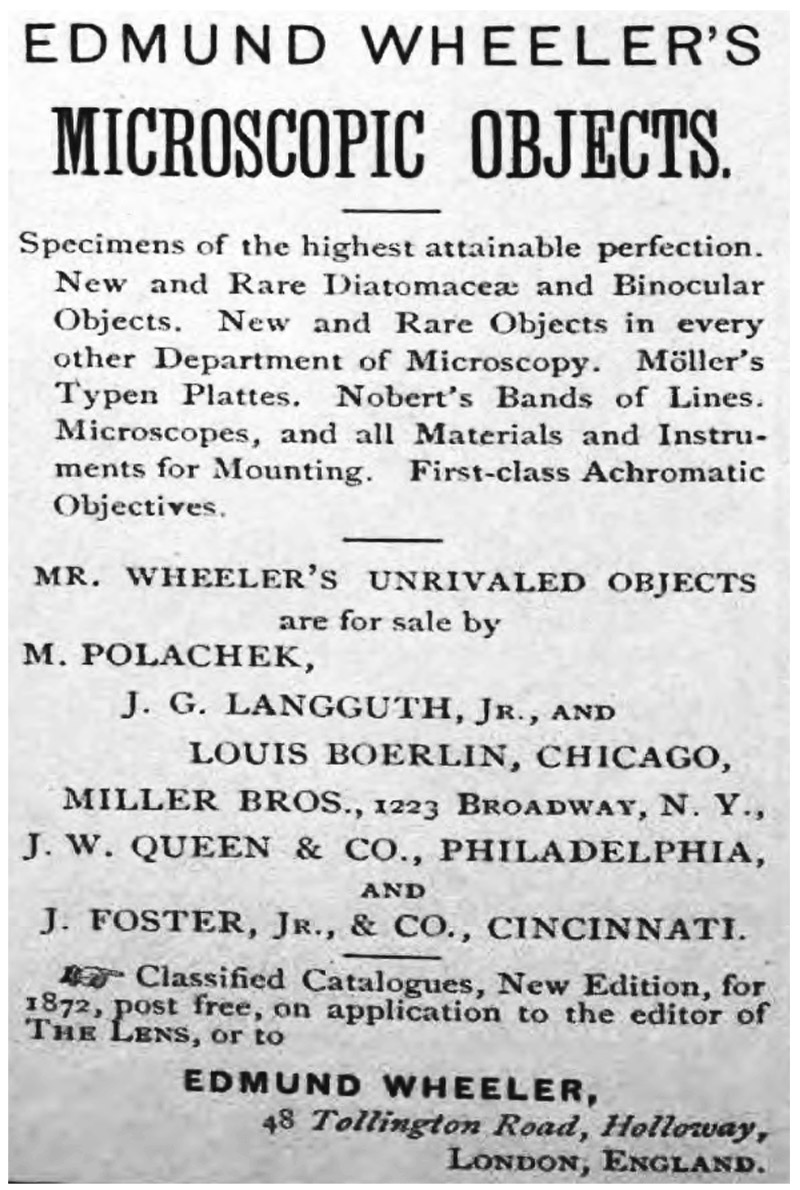
Figure 20.
An 1872 advertisement from the US magazine “The Lens”, listing retailers in that country that dealt in Wheeler’s microscope slides.
He also took advantage of the free exchange columns in magazines to bring his name to public attention whilst acquiring new specimens. From Hardwicke’s Science-Gossip, for examples:
Wanted Vapourer Moths, male and female, and any eggs of insects, for first class mounted objects (1870).
First-class Slides, for Aquatic Larva of Dictiscus, Notonecta. Ephemera, Nepa, &c, and for Volvox, pure and clean. Lepidoptera wanted in the season (1874).
Liberal exchange of first-class Slides, for a pure gathering of Volvox globator, or of other Desmids. Male Glow-worms, and small English Carp-fish (1875).
First-class Slides will be given for unmounted Fleas from Bat, Mole, or Squirrel. Communicate before sending any (1876).
In addition, Wheeler frequently sent sample slides to magazine editors, with the knowledge that free advertising would ensue. One editorial comment from Nature, 1883, stated, “We have received from Mr. E. Wheeler of Tollington Road, Holloway, a collection of mounted microscopic objects, comprising anatomical, botanical, entomological, and other preparations, and we have much pleasure in testifying to the general excellence of the work. One of the objects – a vertical section of the human small intestine – deserves special mention. It shows the glandular cells especially well. The nerves and ganglia of Auerbach’s plexus can be seen, and interspersed among the epithelial cells of the villi and Lieberkuhnian follicles are numerous goblet cells. Space will not allow more than a bare mention of the other objects, including a large transverse section of the stem of Lepidodendron from coal, transverse sections of the stems of spruce fir (Abies excelsa) and mare’s tail (Hippuris vulgaris), the former showing resin canals and sections of bordered pits in the wood cells; Spirogyra in various stages of conjugation, from the first modification of the conjugating cells to the maturation of the zygo-spores; various Diatomaceae, including the rare Coscinodiscus excavata; injected preparations of intestine of cat and toe of white mouse, and various entomological objects. They are all well prepared, and represent a stock which Mr. Wheeler informs us amounts to fifty thousand objects”.
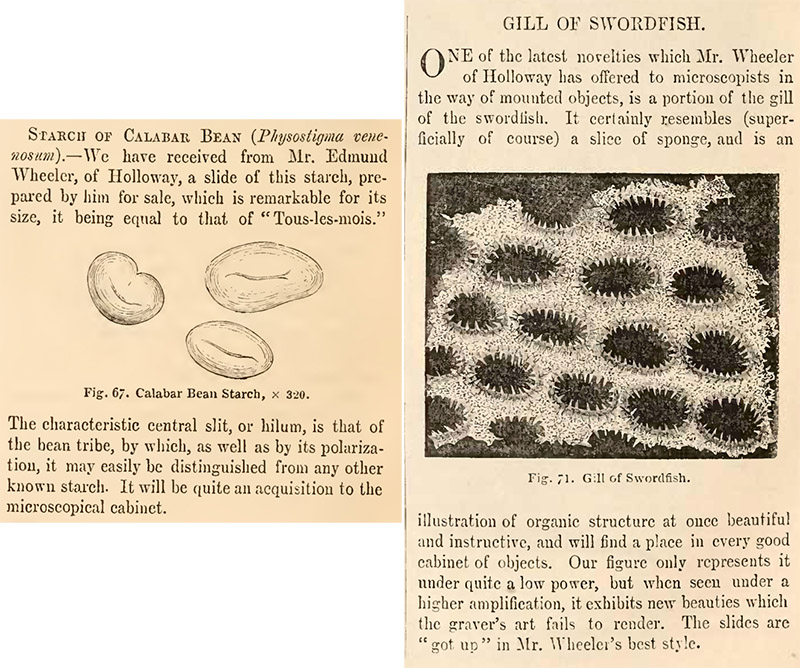
Figure 21.
Reviews of Wheeler microscope slides that appeared in “Hardwicke’s Science-Gossip” in 1870 and 1871. For the price of a donated slide, Wheeler received advertising to the magazine’s international readership.
By the 1880s, Wheeler’s health had deteriorated severely. The 1882 Report of the Ackworth School’s Old Scholars’ Association stated that, “Early in February, Edmund Wheeler came to give us a course of six lectures on Astronomy, but on account of ill-health he was compelled to leave after having given three of them. If it so happen that this is his last visit to us, may he rest assured of the good wishes of those who have had the pleasure of seeing him here, and of listening to him”.
Wilfred Whitten later wrote on what may have been that same lecturing series, “The lecturer and humorist who wrought his miracles on our young minds was far past his own youth, and age soon made his form yet more spare, and his face paler still. One day, on the platform, he fairly broke down. To a friend he wrote that he thought it was his ‘last lecture on this side Jordan’, and he foresaw truly”.
An editor’s note in the August, 1884 Hardwicke’s Science-Gossip reported, “We regret to hear that Mr. Edmund Wheeler, so well known for many years to microscopists, has, through continued ill-health, been obliged to retire from business. No man ever pursued it with more devotion or intelligence. During the many years he was in business, Mr. Wheeler accumulated a large and carefully-selected stock of microscopic material, especially prepared objects. We understand that Messrs. Watsons & Sons, of Holborn, have purchased the whole of this valuable stock, so that it is still available to microscopists”. Subsequent advertisements from Watson prominently announced their acquisition of Wheeler’s business (Figure 21). A desire to maximize profit from that sale may have been the reason why Wheeler amassed an inventory of 50,000 slides.
Enock wrote that, during the autumn of 1884, “(Edmund Wheeler) went down to Brighton to stay with his son Edmund and his wife, and there he gained a little strength, though not for long, and after another relapse he passed peacefully away on December 20th, 1884, aged seventy-six years, having been born on the 25th November, 1808”. His recorded cause of death was “chronic pneumonia phthisis”, i.e. pulmonary tuberculosis, the same disease that carried away his wife and two daughters.
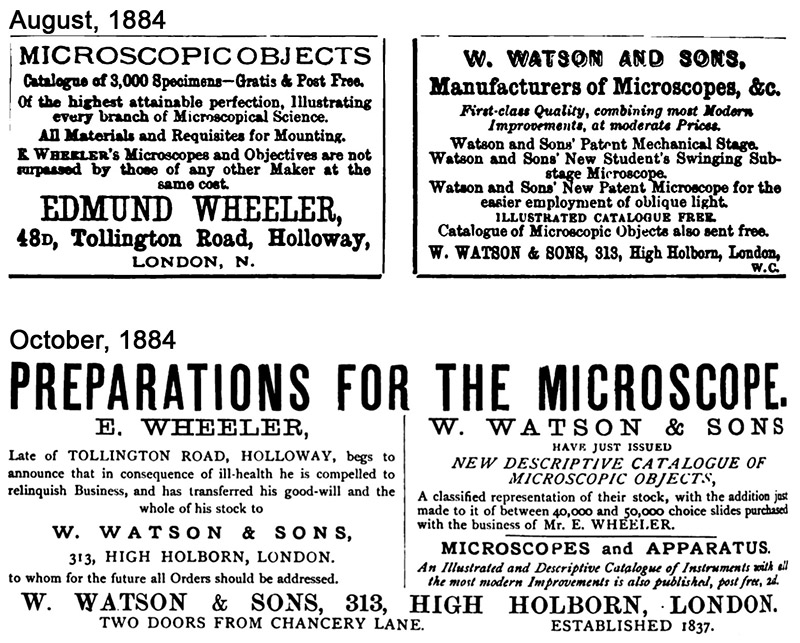
Figure 22.
1884 advertisements from Wheeler and Watson, which appeared in “The Microscopical News and Northern Microscopist” (August) and “Nature” (October). The August advertisements were published next to each other, as illustrated, possibly foretelling Watson’s purchase of Wheeler’s slide business. The deal was sealed by October.
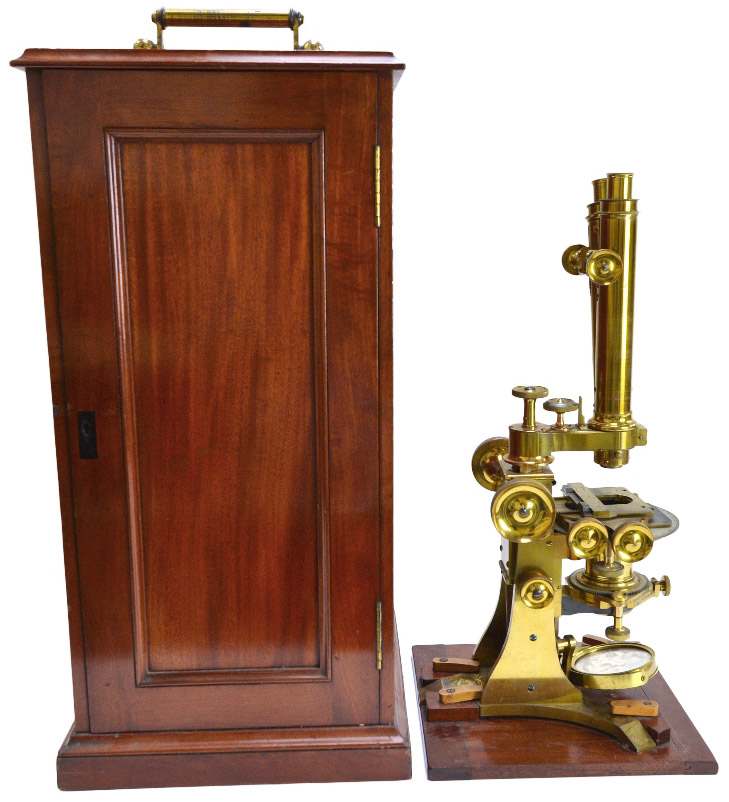
Figure 23.
A Wheeler "Stand A" binocular microscope. It was the top of his line in the 1869 catalogue (see Figure 15, above). Image adapted for nonprofit, educational purposes from an internet auction site.
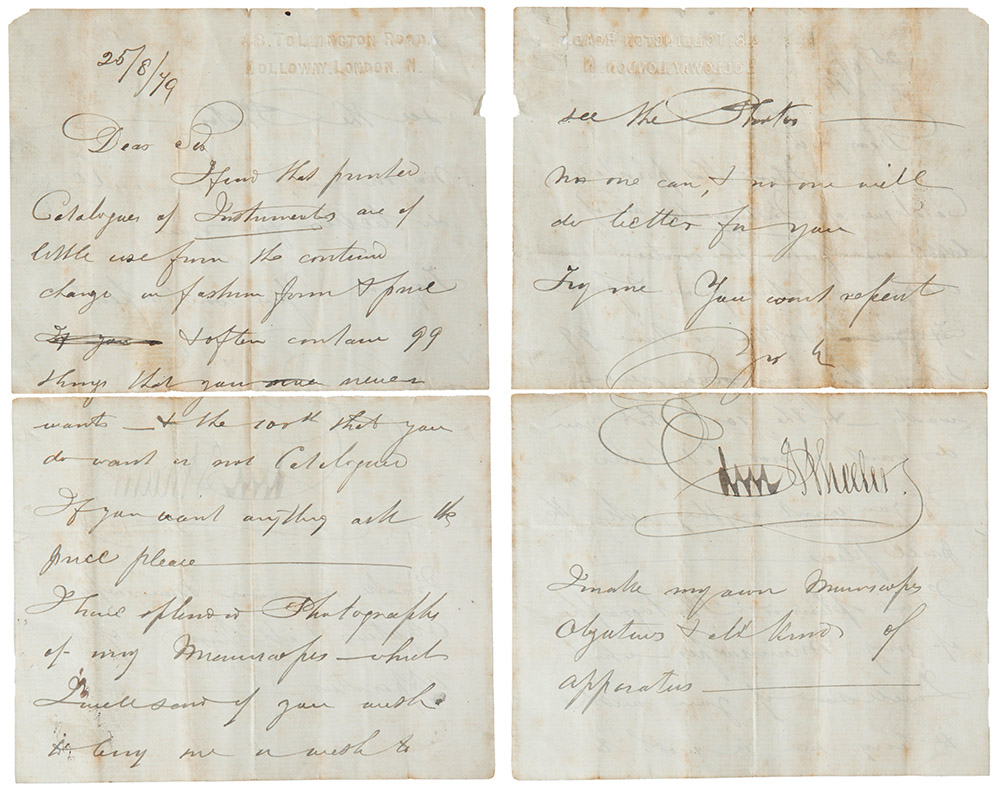
Figure 24.
An letter from Edmund Wheeler to an unnamed customer, dated August 26, 1879. It reads "Dear Sir. I find that printed Catalogues of Instruments are of little use from the continued change in fashion form & price & often contain 99 things that you never want - & the 100th that you do want is not Catalogued. I you want anything ask the price please. I have splendid Photographs of my Microscopes which I will send if you wish to buy me a wish to see the Photos. No one can, & no one will do better for you. Try me, You won't repent. I make my own Microscope Objectives & all kinds of apparatus". Adapted for nonprofit, educational purposes from an internet auction site.
Acknowledgements
Many thanks to Stanley Warren for his continued collegiality, Catharina Clement for generous assistance with records of the Society of Friends and for many helpful comments, John Goodman for providing images of a letter that was written by Edmund Wheeler, and to Howard Lynk, Trevor Gillingwater, Richard Courtiour, and Jeffrey Silverman for discussions and for sharing pictures of Wheeler’s slides and instruments.
Resources
Ackworth Old Scholars’ Association Report (1882) page 55
Ancestry.co.uk, vital statistics and members’ family trees
Annual Monitor and Memorandum Book (1886) Society of Friends, London, page 146
The Athenaeum (1850) Marylebone Literary and Scientific Institution, No. 1196, page 1009
Batcheller, William (1842) A New Dover Guide, fifth edition, W. Batcheller, Dover, page 165 and advertisement at the rear of the book
Bracegirdle, Brian (1998) Microscopical Mounts and Mounters, Quekett Microscopical Club, London, pages 101-102, and plates 11-P, 38-H through R, 48-C, 53-F, and 54-K
The Bradford Observer (1850) Mr. Wheeler’s Lectures, issue 873, November 14
The British Friend (1855) Advertisement: “Sophia Wheeler, aged 17, is desirous of an engagement in a Friend’s Family where its younger members require Care and Instruction. 2 North Buildings, Finsbury Circus, London”, Vol. 12, April advertiser, page 5
The British Friend (1862 and 1863) Advertisements from Edmund Wheeler, Advertising sections of Vol. 20: November, Vol. 21: May
Carpenter, William Benjamin (1868) The Microscope and Its Revelations, fourth edition, J. Churchill and Sons, London, pages 59, 64 and 82
Catalogue of the papers of Sir John Frederick William Herschel 1st Baronet Astronomer (1792 - 1871), http://www.nationalarchives.gov.uk/a2a/records.aspx?cat=117-jh_1-5&cid=-1#-1
The Civil Engineer and Architect’s Journal (1847) Patents issued, Vol. 10, page 264
Clement, Catharina (2011) Quaker education and schooling 1775-1840, The Clock Tower, Issue 22, May, pages 42-48
Cooper’s Journal (1850) To correspondents, page 326
Death record of Caroline Wheeler (1842) Strood, Vol. 5, page 299
Death record of Caroline Mary Wheeler (1843) King’s Norton, Vol. 18, page 294
Death record of Edmund Wheeler (1884) Brighton, Vol. 2b, page 177
Death record of Sarah Anne Wheeler (1863) Islington, Vol. 1b, page 209
Death record of Sophia Wheeler (1871) Steyning, Vol. 2b, page 176
The Goldsmiths', Jewellers', Silversmiths', Watchmakers', Opticians', and Cutlers’ Directory for London, etc. (1863) Barometer and thermometer manufacturers, W. Hogg, London, pages 48-49
Hardwicke’s Science-Gossip (1884) Comment on Wheeler’s retirement and transfer of business to Watson & Sons, Vol. 20, page 184
Hodgson, J. Spence, Frederick Enock, and Wilfred Witten (1904) Edmund Wheeler, Ackworth Old Scholars’ Association Report, No. 23, pages 65-70
Hogg, Jabez (1871) The Microscope, eighth edition, G. Routledge and Sons, London, pages 110-111 and 253
Jackson’s Oxford Journal (1851) A report on city public lectures (delivered 6th October), issue 5137: October 11.
The Journal of the Society of Arts (1853) Reviews of Wheeler’s presentations at Newbury, Windsor, Eton, Leeds and Shippnal, Vol. 1, pages 57, 58, 577 and 591
The Journal of the Society of Arts (1853) Announcements of Edmund Wheeler’s lecture topics, Vol. 1, pages 399, 415, 460, 472, 485, 509, 544, 568, 580, 592 and 604
Kentish Gazette (1835) Report of a fire on the premises of Mr. Standen, chemist, 29th September
Kentish Gazette (1842) Announcement of the transfer of Wheeler’s ironmongery business in Dover to Thomas Ismay, 29th September
Knight, Francis A. (1892) The study of nature, The British Friend, New series, Vol. 2, pages 7-8
Knight, Francis A. (1908) A History of Sidcot School, J.M. Dent, London, page 216
The Literary and Educational Year Book (1859) List of paid lecturers, page 102
Lynk, Howard (2010) Wheeler’s “other” paper, MicScape, published on-line at http://www.microscopy-uk.org.uk/mag/artfeb10/hl-wheeler.html
Mittheilungen aus der Zoologischen Station zu Neapel (1886) Vol. 6, pages 130-131
Monthly Notices of the Royal Astronomical Society (1861) “Edmund Wheeler, Esq., 11 William Street, Upper Holloway… balloted for and duly elected Fellows of the Society”, Vol. 21, page 141
Nature (1883) Advertisement from Edmund Wheeler, Vol. 27, March 15 issue, page cliv
Nature (1883) On mounting and photographing microscopic objects, Vol. 28, page 30
Nodal, John H. (1889) Enock, Frederick, F.E.S., The Bibliography Biographical and Topographical of Ackworth School, F. Nodal & Co., page 10
North Wales Chronicle (1881) A report on Wheeler’s lecture on the telephone, issue 2808, April 9
Official Descriptive and Illustrated Catalogue of the Great Exhibition of the Works of Industry of all Nations (1851) Class V, Royal Commission, London, Vol. 1, page 226
Quarterly Journal of Microscopical Science (1864) Southampton Microscopical Society Annual Soiree, New Series, Vol. 4, pages 57-62
Quarterly Journal of Microscopical Science (1864) Microscopical Society of London Annual Dress Soiree, New Series, Vol. 4, pages 212-213
Quarterly Journal of Microscopical Science (1864) Election of Edmund Wheeler to membership in the Microscopical Society of London, New Series, Vol. 4, page 214
Quarterly Journal of Microscopical Science (1864) Apothecaries’ Society, New Series, Vol. 4, pages 243-245
Reading Mercury, Oxford Gazette, Newbury Herald, and Berks County Paper (1846) Press comments on lectures given by Wheeler in the previous session’s programs at The Mechanics’ Institute, Basingstoke, November 14th.
Reading Mercury etc. (1847) Press comment on Wheeler’s lectures as Vice-President of the Basingstoke Mechanics’ Institute, October 16th.
Reports of the British Association for the Advancement of Science (1847-1849) Lists of subscribers
Smith, Beck, and Beck (1865) An Illustrated Catalogue of Scientific Instruments, Part 1, Microscopes, Dissecting Instruments &c.
Stevenson, Brian, and Stanley Warren (2015) Edmund Wheeler: a man of parts, Quekett Journal of Microscopy, Vol. 42, pages 339-354
Quarterly Journal of Microscopical Science (1864) Dress Soiree of the Microscopical Society (of London), New Series, Vol. 4, pages 212-213
Quarterly Journal of Microscopical Science (1864) Report on the Soiree of the Apothecaries’ Society, New Series, Vol. 4, pages 243-245
Quarterly Journal of Microscopical Science (1864) Report on the Southampton Microscopical Society Annual Soiree, New Series, Vol. 4, pages 57-62
Watson & Sons (1884) A Classified List of First-class Microscopic Objects, etc., 9th Edition
Wheeler, Edmund (1862) Advertisement in The British Friend, November Issue
Wheeler, Edmund (1863) Advertisement for Achromatic Microscopes, Telescopes, etc., in The British Friend, May issue
Wheeler, Edmund (1864) Advertisement for New Achromatic Tourists’ Telescopes, etc., in The British Friend, Vol. 22, July 1, on title page
Wheeler, Edmund (1865) Two letters to Sir John Herschel, in the Catalogue of the papers of Sir John Frederick William Herschel, http://www.nationalarchives.gov.uk/a2a/records.aspx?cat=117-jh_1-5&cid=-1#-1
Wheeler, Edmund (1869) An Illustrated Description of First-Class Achromatic Microscopes etc.
Wheeler, Edmund (1876) A Classified List of First-Class Microscopic Objects, etc., 7th edition
Wheeler, Edmund (1880) A Classified List of First-Class Microscopic Objects, etc., 8th Edition
Whitten, W. (1904) On Edmund Wheeler, T.P.’s Weekly, Vol. 3, page 733